




















At Crown Commercial Service, we know funding Carbon Net Zero (CNZ) projects is a big consideration when developing your plans.

To support this, we have collated a list of open CNZ grants and funding opportunities from across government into a single place.
Find out more at www.crowncommercial.gov.uk/cnz-funding-and-grants


Amajor new study has revealed that the investment in sustainable on-site power generated by UK businesses has the potential to replace imported natural gas by 2035, helping the UK to realise its ambition of becoming energy independent and keep its net zero targets on track.
The report – The Future of Energy: The critical role of business in a zero-carbon world – investigated different sustainable on-site generation scenarios – including wind, solar photovoltaic (PV), battery storage, biogas and biomethane – to assess whether they could feasibly replace the electricity generated from imported natural gas by 2035.
npower Business Solutions (nBS) commissioned Dr Gabriel D. Oreggioni from Imperial College London – working independently via Imperial Consultants – to produce the modelling1. It was based on the projection from the Climate Change Committee’s Sixth Carbon Budget that, by 2035, the UK would require 16 TWh of power from imported natural gas.
It showed that, by 2035, businessesgenerated power could reach:
• On-site wind capacity: between 6 and 29 GW
• Installed roof-top solar PV: 6.5 GW
Biogas power generation: up to 16 TWhe
Hydrogen and biomethane injection: 33 and 7.5 TWh, respectively
1 Study conducted May-June 2022
The report also revealed that, depending on the scenario, the overall levelised cost of electricity could range between £49 and £261/MWh – lower than current wholesale prices – and emissions savings of up 6.7 MtCO2/year could be achieved, resulting in a huge contribution to achieving the UK’s net zero goal.
Anthony Ainsworth, Chief Operating Officer at nBS, commented: “For more than a year, the UK energy market has experienced a period of unprecedented volatility, with resulting high wholesale prices impacting all businesses, alongside questions around energy stability. Earlier this year, our Business Energy Tracker revealed that 77% of businesses put energy as their top business risk. It also showed that, to protect themselves from this risk, many businesses are installing sustainable on-site generation to both reduce emissions and increase resiliency.
“So, we wanted to explore this further – what if there was a future where businesses are not only more self-sufficient, but where the power they generate could help reduce energy costs and the UK’s reliance on imported natural gas? For us, this report is really exciting – to see the potential for businesses to become central to a changing, decarbonised and decentralised energy system that is powered by renewables.
“For businesses, it also shows the investment decisions they make now when it comes to sustainable on-site

generation could reap rewards today and into the not too distant future including lower energy costs, increased resiliency, reduced emissions and a more stable power supply.”
The report also concluded that there would need to be policy interventions from the government to unlock the power potential of business. These include streamlining planning rules and more tax incentives to enable businesses invest in sustainable on-site generation, as Anthony Ainsworth argues:

“Short-term plans are in place to support businesses this winter, with the Energy Bill Relief Scheme providing some protection against rising prices.
“However, there is also a need for a longer term approach, both in terms of incentivising energy efficiency and encouraging more businesses to consider investing in sustainable on-site generation.
“We believe this report demonstrates the real potential of business-generated power and how it can contribute to the national agenda of energy independence and net zero – both now and in the future – if policy is there to support it.”
The Future of Energy: The critical role of business in a zero-carbon world is available to download from https://npowerbusinesssolutions.com/ future-of-energy
Leading UK smart sensor manufacturer Pressac has helped car company Toyota more than double its energy cost savings.
Energy monitoring sensors, which measure how much power is flowing through a cable, have helped the company discover exactly which parts
of its production processes are using excess energy. The information will play a huge role in Toyota’s goal of becoming carbon neutral by 2050.
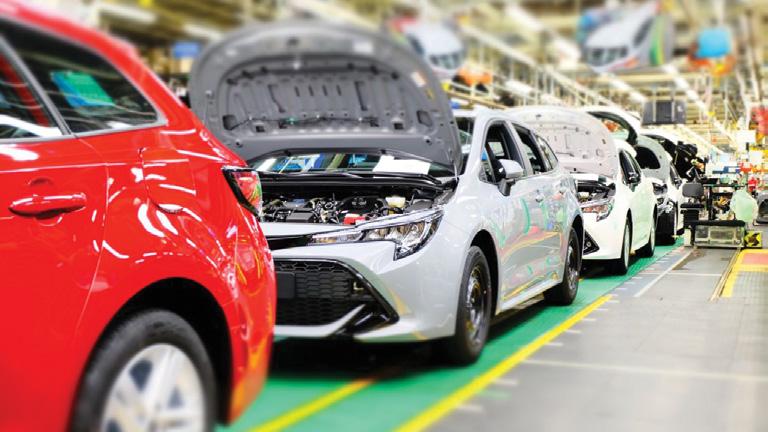
Around 300 of Pressac’s wireless current transformer (CT) clamps have been installed at Toyota’s manufacturing plant in Burnaston, Derbyshire. By clipping them around individual cables, the company were able to see, for the first time, how energy was being used at machine level.
Previously, the company had been able to view energy consumption at transformer level but did not have the granular detail about each piece of machinery – information which is already making a big difference.
In the case of one injection moulder,
which was identified as ticking over at a high power level, changes were able to be made which have resulted in its energy consumption in non-production periods being reduced by 82%.
Pressac worked with ESCO, the Energy-reduction Support and Collaboration function of Toyota to set up initial data visualisation. The sensors, manufactured at Pressac’s Nottingham headquarters, transmit their data wirelessly to Toyota’s existing building management systems via MQTT, a common Internet of Things protocol.
Pressac also supplied the company with air quality sensors to help ensure the production zones provided the optimum conditions for team members to work in. https://www.pressac.com/
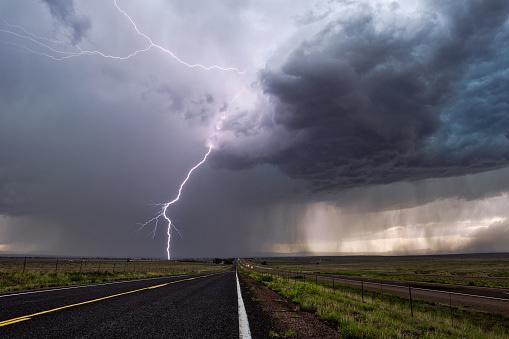
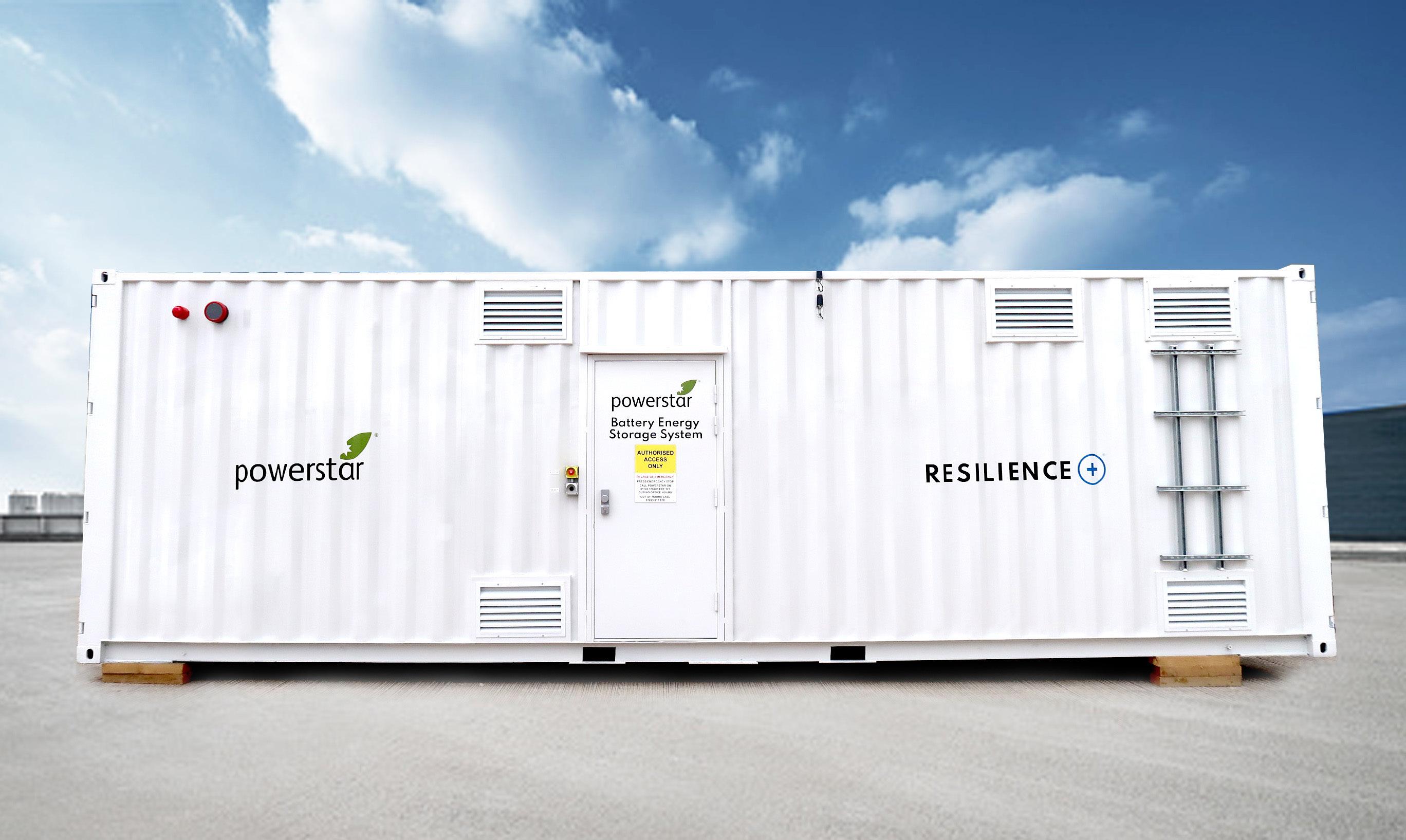









With COP27 just kicked off, businesses’ climate and sustainability initiatives are once again being thrust into the spotlight. Clear, impactful and data-driven decarbonisation strategies are more and more acknowledged as a business imperative. Recent events such as global lockdowns, war in Europe, energy crisis and the threat of an economic recession have served as a reminder how business priorities need to stay steady when it comes to climate change, despite such a volatile environment.
In fact, the latest IEA World Energy Outlook report shows that the global energy crisis is causing organisations to hasten their decarbonisation plans. In addition to demand for fossil fuels plateauing for the first time, the report states that global clean energy investments are set to increase dramatically by 2030.
How then, can leaders ensure their climate strategy is fit for the long term, robust enough to resist the headwinds of an environment that will stay volatile and focused on short-term implementation?
It all starts with conviction – organisations must establish the ‘big why’. Leaders need to invest and spend time instituting a baseline for their strategy, understanding the opportunities, and evaluating the risk. All angles should be examined, and the executive team should reach fundamental alignment on sustainability plans, at board and executive levels. Aligning a leadership team on the fundamental belief that the world is going to decarbonise eventually and thus the value will be there is the first step every business needs to take. It is not about doing the ‘right’ thing for the world, it is about doing the ‘right’ thing for one’s business.
Often, leaders centre the conversation around cost and ignore the potential impact on positive additional bottom line as most of the low hanging-fruit sustainability implementation programs are in the money, not even talking about brand, product and overall, the future of the organisation. An organisation’s reputation can take a lifetime to build, yet seconds to destroy. A strong decarbonisation strategy can add buoyancy to a sinking reputation and help with customer retention and loyalty in times of trouble. The impact of a strong decarbonisation strategy cannot be underestimated, so leaders should work to ensure their strategy is rounded, thorough and well informed.
Mathias Lelievre, CEO, ENGIE Impact

To best mitigate risk, data should inform all financial decisions. Good, clean data that encompasses Scope one, two and three emissions will allow organisations to best understand the financial levers available and produce the right financial action. Leadership can drive change and commitment, so leaders need to understand the financial opportunities alongside the risks. Exploring potential pilot programmes and financing options, understanding how efficiencies can come at scale, and analysing whether it’s cost saving compared to the current situation, will help organisations optimise their financial business case when preparing to implement their decarbonisation strategy. Building awareness and governance
It’s all well and good leaders being aligned on their decarbonisation strategies, but what about the rest of the organisation? Whatever the balance of talent is, everyone involved has to have a full understanding of how the business works today so they can shape how it will work tomorrow. Employees who share a fundamental understanding of key decarbonisation levers and how these may evolve in the future allow an organisation to trial multiple options to establish the best path forward.
Leaders should also try and implement a cultural change within their organisation, wherein decarbonisation plays a pivotal role in all business endeavours. Leaders must inform employees of the organisation’s climate commitment, make clear the steps that are being taken, and ensure each employee is aware of the role they play. This creates a shared vision of success and empowers employees to play their part in reducing an organisation’s climate impact. Leaders should also ensure employees are updated on progress, allowing them to see the impact they are making through the decarbonisation data. The attention around greenwashing will only rightfully increase and highlights the importance of creating a robust, transparent, data-driven decarbonisation strategy. It’s not only employees who need to be on board, but customers, shareholders, and all stakeholders.
Finally, it’s imperative that we shift the way we look at performance to encompass decarbonisation the same way we look at financial performance. This requires strong governance frameworks including more than
just a one-year picture of one’s carbon footprint, but also the new processes and tools needed to steer decarbonisation performance, month after month, quarter after quarter.
With the weight of increased pressure from stakeholders, long-term growth impact, and established science on their shoulders, leaders should avoid delaying their decarbonisation strategies and focus on what they could get done now. Though a short-term shift to carbon intensive fuels may seem like an easy option in the current environment, a temporary break from a defined net-zero strategy could get companies off track if they start adjusting goals or pushing timelines.
Leaders must hold their ground and trust in their strategy, especially if they took the steps of establishing their ‘big why’ deep in the organisation. The instability of the global economic and geopolitical status is nothing novel and we can anticipate that the energy sector will stay very volatile while we accomplish our global transition. A robust decarbonisation strategy can help organisations remain competitive and attractive in such turbulent times. Climate change is not going away on its own, and leaders like in every other aspect of managing a business need to make decisions and trade-offs with both a long-term view and short-term focus.
While the onus to reduce climate change falls on each and every one of us, leaders must take responsibility for their organisations’ own decarbonisation commitments. Leaders who take time to build their decarbonisation strategy, base their decisions on data, transform the way they manage performance and are transparent with their employees about plans and achievements will stand strong, especially during turbulent times. These are the leaders who will see their climate strategy have an impact long into the future. https://www.engieimpact.com/







Climate change is the defining crisis of our time and a rapidly escalating issue that has left many with a sense of hopelessness and helplessness. Thankfully, new initiatives and developments are taking shape, giving public sector authorities and certain industry segments some power to take action to reduce emissions. Collective efforts are instrumental to combatting this crisis, and companies that commit to reaching their net-zero targets will become the most significant agents of change for our future.
Net-zero is considered critical to insulating the world against the worst effects of climate change. If achieved, it means that human CO2 emissions will no longer exceed the amount of CO2 we remove from the earth’s atmosphere. Its importance has led to governments and corporations around the world pledging to meet such targets by 2050. But are net-zero emissions possible by 2050? I believe they are, however, meeting them will require substantial change and determination.
Following the World Economic Forum Annual Meeting in Davos this year, it was confirmed that digital technologies, such as artificial intelligence, machine learning and automation – scaled across industries – have the power to accelerate decarbonisation efforts and reduce emissions by up to 20%. While it is understandable why people are losing faith in the future and being impacted by eco-anxiety, these findings give us hope by uncovering how digital solutions could pave the way for achieving sustainable outcomes that align with net-zero targets. In fact, if scaled, digital solutions could be most effective at reducing emissions in the three highest emitting sectors – energy, materials and mobility.
But to make this possibility a reality, high-emitting industry sectors must rethink their strategies to leverage efficiency, circularity and sustainability.
The predictive and productive power of digital solutions With the support of digital solutions, the energy sector can reduce carbon-intensive operations and, subsequently, emissions by 8%, according to estimates from the World Economic Forum (WEF). To successfully transition to more renewable energy sources, utilities suppliers need to develop better methods for estimating how much energy is required so that they can make better use of resources –including systems, staff and partners – and fill any gaps with renewables. One such method is machine learning (ML), which can anticipate energy outputs and demands through its data analysis. We’re finding that these forecasts can then help industries effectively
Saranjit Singh, VP Telecommunications and Utilities APAC, SS&C Blue Prismimplement climate change strategies while reducing inefficiencies and carbon emissions.
The benefits of these ML algorithms extend beyond the utilities sector and can be used in any business, across industry verticals. As a result, more accurate supply and demand forecasting contributes to drastic cuts in manufacturing and transportation waste through improved understanding of what’s needed and when. Targeted suggestions for lowcarbon items can also drive ecologically responsible purchases by helping to optimise power usage and avoid unnecessary storage and waste.
Intelligent automation (IA) solutions can also improve sustainability in vital industries, such as manufacturing, infrastructure and data centres. We’re seeing organizations reduce emissions by employing data automation and modelling to digitize and analyse processes and develop predictive maintenance and monitoring capabilities.
Although IA algorithms that anticipate energy consumption already exist, we think there is room for improvement to ensure they can keep up with the multiple sources of energy production today and the need to meet new and evolving regulatory and measurement requirements. Complex algorithmic features also need fine-tuning to be able to react to changing trends or behaviours, and to expand beyond the industrial level to cater to family and individual demands.
One-stop digital solutions such as IA not only boost efficiency and production, but they also enable the development of new procedures that reduce power consumption and harmful emissions, directly and immediately contributing to the fight against climate change.
Artificial intelligence (AI) has the power to support climate action by reducing waste in all forms (financial, temporal and material). The problem is that even amongst the many firms that utilize a high level of automation, a fragmented approach to AI is often adopted. This stifles transformation, wastes valuable time and staff resources and generates “technical debt” (referring to the costs that arise from organizational reworks needed due to sub-optimal solutions being originally chosen for fast, short-term results).
Organizations need to re-imagine their existing strategies and use varied yet complementary technologies that work
together, rather than in isolation, to maximise efficiency and reduce waste. AI-managed energy systems can then identify the appropriate amount of energy consumption needed at any one time. These insights support the fight against climate change by minimising energy waste, simplifying processes and maximizing productivity by creating efficient and unified workflows.
The future ahead may be rife with daunting uncertainty, but there are still limitless opportunities to generate innovative technologies that drive forward climate goals. Only five years ago, a company’s intelligent automation objectives often outstripped the capabilities of available technology. The market hype around advanced technologies didn’t deliver the promised business results. Since then, automation technology has progressed significantly, as billions of dollars have been invested in research and development. The prioritisation of generating digital solutions in this sector, including the use of process analysis and predictive maintenance to reduce energy waste, has done much to accelerate the journey to reaching net-zero.
AI-enhanced digital solutions can assist with the development of tools that will help individuals and businesses understand their carbon footprint and outline steps to decrease it. In an example of the potential of digital solutions, the revolutionary World Bee Project harnesses the power of technology and science to enhance the wellbeing of bees and other pollinators. The collective effort has created the world’s first global bee database, which collects data intelligence from monitored colonies around the world. Monitoring sensors capture and combine data points, such as hive temperature, humidity, pollinator decline and deficiencies. These data points support the creation of solutions that maintain a healthy and sustainable ecosystem.
Digital solutions that are currently available present an actionable step towards net-zero and can help to prevent unnecessary damage from the climate crisis. Organizations that have committed to such targets will not only be able to reach their goals by continuing to employ digital solutions, but will also do so faster as they implement intelligent automation to simplify work processes, reduce waste and contribute to a sustainable and brighter future.
https://www.blueprism.com/

Steam – this extraordinary, energy dense, fluid which is irreplaceable in all kinds of industries to heat, power and sterilize – leaving nothing but water behind. And with advancing steam generation solutions, steam is part of our sustainable future.

This is Natural Technology.

When steam’s work is done, it leaves only water behind.
Carbon Capture, Utilization and Storage (CCUS) consist of a series of technologies to capture carbon (usually as CO2) emitted by various processes, to then either be used or stored in an underground reservoir.
Carbon capture can be achieved as part of an industrial process, such as hydrogen, ammonia or ethanol production or natural gas processing. CO2 can also be separated from exhaust fumes of power generation, cement or steel plants; or even be separated from atmospheric air. This direct air capture process requires handling a huge volume of air, as the natural CO2 concentration is very low.
There are different technologies to achieve this actual capture, relying on some chemical or physical absorption mechanism, or based on membranes.
There is still a lot of R&D going on to finetune these processes which so far are mainly relevant for large facilities; there is no carbon capture technology yet that could be deployed on each individual gasoline or diesel engine.
• Utilization of CO2, today, is mainly done in the Oil and Gas industry (Enhanced Oil Recovery (EOR)), in the Food and Beverage industry, as well as for Urea production. But the necessary volumes are limited and already well covered.
• Other potential uses include uptake by algae, conversion of fuels and chemicals and mineralization of inorganic materials (e.g., adding a layer of carbonate around granulates used for concrete). Conversion into various types of fuels will of course end up in release of the same amount of CO2, this time likely in smaller applications or engines with no carbon capture capability.
• CO2 can be stored in a saline aquifer (but this option will compete with storage of natural gas, like for winter or strategic reserves setup). CO2 can be also stored into a depleted oil or gas field, where it is injected via a refurbished production well. The CO2 will migrate in the full underground reservoir and will mineralize over time, thereby eliminating any risk of leaks in the distant future.
• One relevant research area in the years ahead consists of finding economical applications for utilization of the captured CO2 in a variety of industries, aside from geological storage.

SO, IS CCUS THE SOLUTION TO RISING GLOBAL TEMPERATURE?
COP26 in Glasgow signalled a major boost for the future growth prospects of CCUS projects. Due to the growing political consensus among major emitting countries at COP26, the adoption of IEA Net Zero Carbon emission target by 20501 has increased. It is widely acknowledged and noted on the latest IPCC Report that the contribution of CCUS is a critical part of achieving the Net Zero Carbon target by 2050, although current rates of CCS deployment are far below those in modelled pathways limiting global warming to 1.5°C or 2°C. Accordingly, the supply of CCUS will have to face significant expansion in the years ahead, as the following data shows.
Today, only ~40Mtons/year CO2 emissions are captured, which is 0.1% of the 40Gtons/year global emissions from industry and energy. Staying in line with the IEA Net Zero Carbon emission target by 2050 would require boosting capture capacities to 850Mtons/year by 2025 and to about ~8GT/year by 2050. So CCUS is definitely a technology worth investigating, especially for hard to abate processes and industries.
But there is a major prerequisite to the development of this CCUS technology.
CCUS add a cost to existing processes, this cost can vary from about $20/ton in the treatment of natural gas, to about $50/ton in the production of Blue Hydrogen. It ranges from $40 to $80/ton in power generation and can be above $100/ton in steel or cement production. Direct air capture cost can be in the $140 to $300+.
Contrary to other decarbonization measures such as electrification or energy efficiency which may have a reasonable payback and/or generate added value on the process, CCUS
1 COP 26 refers to the 26th Conference of the Parties to the UN Climate Change Convention (UNFCCC) recently held in Glasgow U.K.
growth will depend on government incentives, sustainability regulations and development of the global carbon market.
In order to facilitate the development of CCUS projects, the US use the 4Q Tax credit structure which provides capturing parties a tax credit of $35/ton for CO2 used in EOR operations and $50/ton for CO2 directly stored in Geologic formation. Such incentives for example support the Development of the “Green Pipeline” (Denbury Resources) that Transports CO2 sourced from Facilities in the Gulf Coast, for injection in EOR in LA fields.
As an example of a working CO2 market in the EU Emissions Trading System (EU ETS) world’s first major carbon market, EU ETS carbon prices have passed the €60/ton threshold end of 2021. Some analysts estimate it is on track to reach €90/ton by the end of the decade. These can create further incentives for industries to abate CO2 specially as liquidity improves as well as prices. Investors also are increasingly pressuring publicly traded companies to have proper policies leading to reduction in CO2 – creating another strong incentive given the potential impact in their stock prices.
COP26 produced some good news in this regard. Most strongly backed by the US, the Net Zero initiative announced significant financial and technological assistance to ramp up the implementation of CCUS; as well as other mitigation technologies in partner countries starting now in 2022. This new initiative is intended to accelerate global energy system decarbonization. It will support partner countries to achieve net zero in their energy systems. It will develop technical roadmaps and then fund technical assistance and capacity building, including access to expert assistance in the US, specifically from the national laboratories and financial support for in-country technical institutions.2
Also, at COP26 the US Department 2 https://ieaghg.org/ccs-resources/blog/netzero-world-initiative
of Energy (DOE) launched two initiatives aiming to catalyze the growth of a global Carbon Dioxide Removal (CDR) industry; including CCUS, but also including storage, enhanced mineralization, direct air capture, among others. The objective is to stimulate removal and durable storage of gigatons of CO2 for less than $100/t this decade. This is the US government’s first major effort on CDR innovation, with a “whole-ofgovernment” approach. It aims to catalyze a global CDR industry by increasing R&D, harmonizing LCAs and technoeconomic analyses, and facilitating pilot tests, to achieve 100 million tons of CO2 per year by 2030.3 Cooperation on CCUS were also specifically mentioned in a Joint Agreement between US and China at the COP.

Major private firms that are already implementing CCUS projects also lobbied at COP26 to increase both public and private financing of CCUS technologies, including government policies and public investment to scale up deployment of CCUS projects.4
Another condition for success of CCUS, in addition to national (and 3 https://ieaghg.org/ccs-resources/blog/uslaunches-two-initiatives-on-cdr 4 https://www.carbonclean.com/carboncapture-cop26
probably regional) incentives and regulations, will be the creation of an ecosystem, or hub, or cluster, as already highlighted by the most mature projects. Such a hub will need one or several ‘supplier(s)’ of CCO2, but also a network of pipelines, a depleted oil or gas field, the right injection facility, and the monitoring over time of the complete system, in particular CCO2 inside the reservoir.
This implies the need for CCUS clusters to be located close to a depleted Oil and Gas field and will also require the proper Pipeline infrastructure to collect the CCO2 and injected into the reservoirs.
There are such potential locations around the North Sea or in Texas (Permian Basin/Houston/LA area), where some of the initial projects have taken a hold – some lead by major Oil and Gas (now Energy) Companies, however countries lack Korea or Japan lack access to such formation.
These countries without such formation and legacy Oil and Gas infrastructure explore either the capture of carbon as a solid powder (not as CO2), or various utilization options, making carbon capture integral to industrial plant design.
Finally, there is another often neglected condition for the success of CCUS projects.
We are speaking about large installations, adding about 10% cost and ‘hardware’ to an already large process such as power generation or
steel or cement plant. There is little experience on industrial scale carbon capture processes. The developers and EPCs need to ensure the proper design, define the right power and process architectures, optimize operations and maintenance. Safety and cybersecurity should not be neglected either.
Building the necessary pipeline infrastructure, to collect/transport and inject the CO2 to reservoirs can represent up to 20 to 30% of a CCUS project. Such infrastructure is to be utilized by the industries that are capturing the CO2
Selected Oil and Gas companies have legacy experience in the safe, reliable transportation of CO2 and are becoming major actors teaming up with industry to address the transportation needs, either repurposing existing infrastructure and/or building additional ones.
The building of CCUS assets and ecosystems, depending on government subsidies and regulations, will require the industry to also develop partnerships with the right suppliers of automation, energy, and software technologies that can support them in this journey to repurpose or develop the new infrastructure and ensure they are managed and operated using the proper technology.
Contributors: Jean Acquatella PHD Environmental Policy
https://www.se.com/

Launched in 1992, Prime Light is a leader in the UK commercial lighting industry. They provide components, controls, and custom lighting solutions for every type of business purpose. As they reach the end of their third decade of successful operation we ask Prime Light’s managing director, Sean Hounslow about the past, present, and future of the organisation.
Thirty years is a long time in business. What are the biggest changes you’ve seen in the UK lighting industry since 1992, and how has Prime Light evolved to meet these changes?

The most obvious change has been the shift in manufacturing. In recent years, a substantial portion of the lighting fixtures market has shifted to the far east, with China being the largest manufacturer.
Fortunately, Prime Light had the foresight and agility to adapt, and we embraced this sea-change very early on. While many other UK lighting businesses failed, the rapid shift to offshore enabled us to grow organically and through select acquisitions. Thirty years ago, we were a small business with a small product range, simply feeding OEM and replacement parts to lighting manufacturers and distributors. Now, in addition to maintaining our expanded base in manufacturing and distribution, we offer more than 50,000 products, own a cluster of strong brands, and offer OEMs and end users such as retail
and local authorities off the shelf and custom lighting and control solutions suitable for most applications.

Prime Light has grown from a lighting components provider into a resource that offers so much more. What else will the organisation be offering soon?
We’ll be doing our bit to save the planet with our 3Rs approach – Reduce/ Reuse/Recycle. Far too many luminaries and lighting components end up in landfill at the end of their service life. This is wasteful and polluting and it must stop. We’re working with our customers and our designers to develop a ‘cradle to cradle’ life-cycle, with a high percentage of defunct components being reused or recycled into new products. This reduces waste and the helps the environment by lowering demand for raw materials. We’re also taking this approach a stage further by building easy replacement features into many of the products we offer. This gives our components a longer life as obsolete parts can be quickly swapped out as lighting technology evolves.
Lighting used to be focused on simple illumination or
display, but now it’s also used to direct retail traffic flow, alter interior usages, in emergency interventions and to deter crime. How else do you see lighting being used for commerce in the future?
The next big thing in lighting will be mood enhancement. Current lighting products used to create atmosphere or influence human behaviour, such as dimmers, or simple colour changes, are quite crude in their utility. ‘Tune-able lighting’ will be revolutionary in comparison.
Tune-able lighting can provide a complete palette of colours and light intensity coupled to intelligent control. This allows interior and exterior spaces to react to time of day, events, space utilisation, human presence, and a range of desired behavioural results. Science has revealed the presence of a third photoreceptor in the eye that influences our mood and brain function. Tuneable lighting could tap into that signal stream to enhance our emotional senses and increase our feelings of well-being. For example, to drive an increased sense of comfort and satisfaction.
Wow.
Yeah. It’s pretty cool. Sustainability was barely on the radar in 1992, now it’s the number one topic in business. What is Prime Light doing in the race to net zero?
Apart from the radical changes we’re making to reduce landfill waste, we’re
also working hard to reduce greenhouse gases by making business lighting more energy efficient. Adopting LED lighting and smart controls across all our facilities has reduced our lighting energy consumption by 40%, and we’re loudly communicating these kinds of benefits to all our customers, particularly end users. Installing high-efficiency lighting and smart controls to optimise usage does more than help a business get closer to their net-zero goal, it also reduces their power bill. We’ve proved that in some applications, businesses can receive payback on their investment within a few months. After that, it’s all good news, with continued and significant savings in both money and CO2 emissions.
How has the Prime Light mission evolved over the years, and what benefits do your customers gain from the special knowledge and experience of your team?
Innovation drives everything we do. We’ve gone from a simple components provider to a sophisticated solutions provider, and we provide everything from ‘just in time’ supply, to intelligent systems for retail, hospitality, logistics, manufacturers and more. Our customers know we think outside the box and that our team has the depth of skill and experience to deliver the solutions they require. Seamless service and cutting-edge technology are what Prime Light is all about.
If you could predict life at Prime Light in 2052, what will the company be doing
I would hope that our current path towards innovation and as a solutions
provider has expanded and that we are not only larger in terms of business, but also in the scope of our operations. I see Prime Light as continuing to be the ‘go to’ resource for anything and all things in commercial lighting and interior/exterior and environmental control systems.
Lastly, what lighting technology would you love to see invented?
A light source that powers itself without burning natural resources. Like perpetual motion?
Well, maybe not as far-fetched as that. Although the source would have no wires attached, and it would be controllable and fully programmable, with returnable data sensors built in to report on movement. The light source could be powered by a permanent natural feature, such as temperature change, the flux between day and
night, or even the pull of gravity.
That would be a game-changer.
Will Prime Light sell it?
Definitely.
IS YOUR BUILDING FUTUREREADY, AND HOW CAN PRIME LIGHT ASSIST YOU?


Prime Light provides smart lighting solutions for all types of purpose and for every type of business. Talk to us before you begin the process of planning your next commercial construction or replacing your building’s existing lighting system.

Prime Light – the experts for commercial lighting components and controls. Contact us now.
Prime Light: https://primelight.co.uk/ Sean Hounslow – Managing Director Contact- 0208 968 2000.


Businesses looking to invest in an intelligent lighting system for their work facilities will find a wealth of products at their fingertips. Climate change has accelerated the speed at which lighting management is innovating, as has the recent RoHS ban on T5 and T8 fluorescent tubes. The results are not only exciting, but game-changing from an energy-saving perspective. A comprehensive, networked amalgamation of all the lighting controls within a building leads to an impressive reduction in energy consumption that cannot be replicated by alternative methods, such as switching to LEDs alone.
In July 2022, LEDVANCE conducted its own research into lighting and the impact it has on the environment, and subsequently global warming. The results showed that while energyefficient luminaires certainly help reduce lighting’s impact, there reaches a point where the energy savings plateau and increasing lumens per watt is simply not enough. An intelligent sensor-assisted light management system which can switch on and off or dim the light increases efficiency past this point by saving consumption. It is therefore not just useful, but essential, for businesses to reap the benefits of energy saving from intelligent light systems.
Facilities managers will be reassured to know that within the wide selection of systems available is an exceptional choice of customization options that tailors the lighting to what a facility and the workers within it need.
The scope of sensor programming on offer in the lighting management sphere means that there’s settings to fully customize a building’s lighting according to how the facility is used and its hours of operation. Presence detection avoids unnecessary illumination in empty corridors or meeting rooms, and daylight sensing reduces the lighting from luminaires during the brightest parts of the day.
When considering the benefits of automated lighting systems to their spaces, facilities managers will generally note convenience and cost benefits.
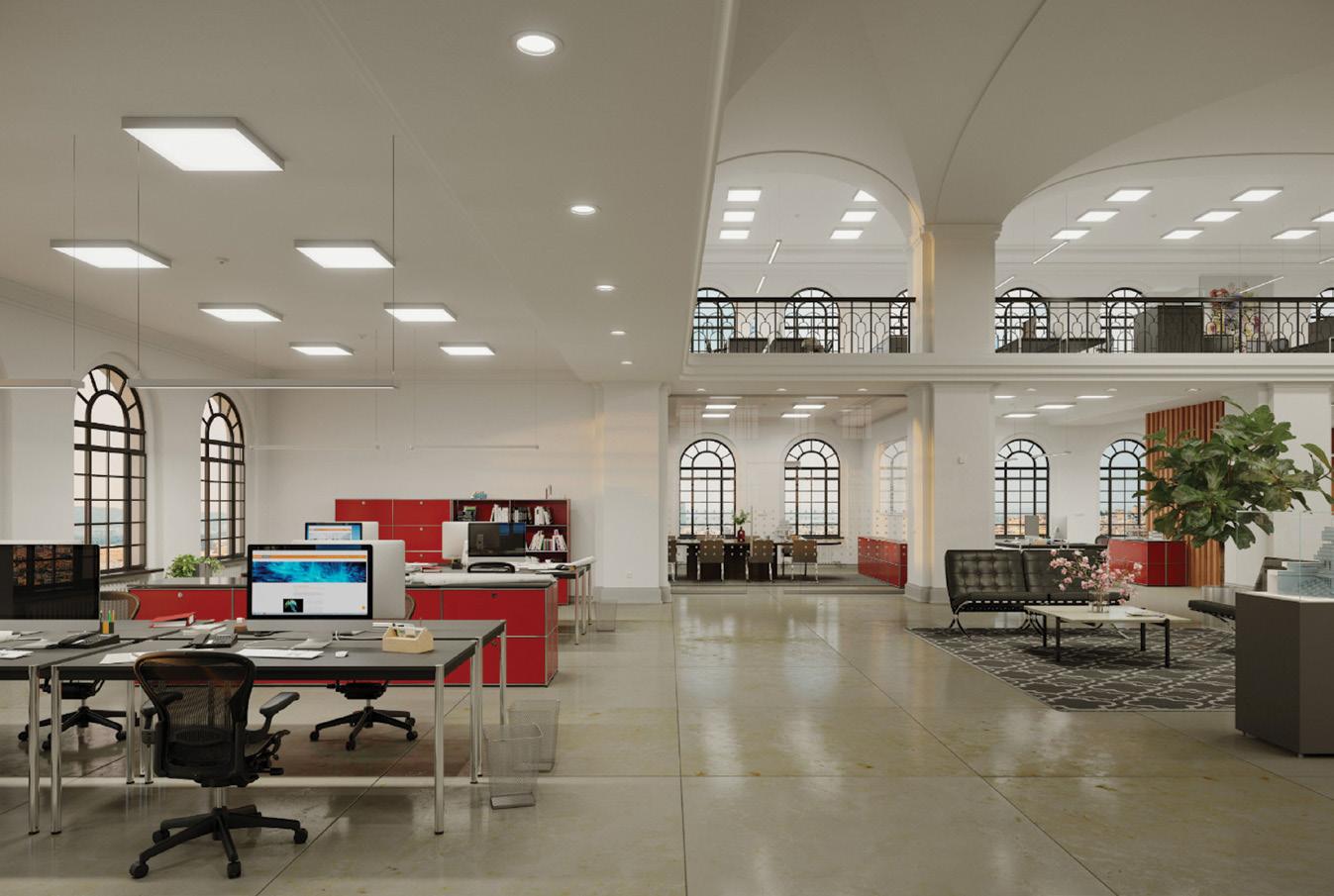
However, these systems can have an additional positive impact on wellbeing and productivity, as automated systems provide the valuable opportunity to adapt lighting to the circadian rhythms of staff.
The circadian rhythm is our 24hour body clock that governs natural cycles of activity and rest by managing hormone levels. Humans are known to be heavily influenced by variations in natural light throughout the course of the day. A human oriented lighting concept uses smart controllable LED lighting systems to simulate the characteristics of natural daylight, combining the visual and non-visual biological effects of light through changing colour temperatures and illuminance levels.
Artificial light that synchronises with our circadian rhythms is proven to make us happier, healthier and more productive. It has been scientifically proven that spaces which use human centric lighting systems increase staff wellbeing, concentration and performance during the day, improve the quality of sleep at night, and helps reduce sickness. Therefore, an automated lighting system with HCL programming will not only illuminate an office facility but support the wellbeing of everyone within it.
Intelligent lighting systems can be adapted not only for building usage, but for the building itself. Whether the system is being applied to an existing facility as a retro fit installation, or to a new build, management systems provide options.
LEDVANCE VIVARES Zigbee works with a controller that communicates with up to 200 compatible devices using the highly reliable Zigbee 3.0 wireless standard. This makes the system a first choice when no additional control lines should or can be laid, such as when modernizing existing buildings or refurbishing listed buildings. VIVARES Zigbee is also ideal for changing room situations because the system is flexible and easy to adapt.
VIVARES DALI is suitable whenever additional control lines can be laid without any problems, such as in suspended ceilings, when retrofitting existing DALI installations or when equipping new buildings. The VIVARES DALI system can also be integrated into a higher-ranking KNX system for building control using a KNX interface. This means that automated tests, including reporting, can be carried out on any emergency lighting system.
The above offers just a glimpse into what light management systems have to offer for businesses assessing their energy saving opportunities in this field. There’s even more choice out there on the market and, given the rapid developments within this product sector, there’s bound to be even more innovation on the way. Watch this space. https://www.ledvance.co.uk/
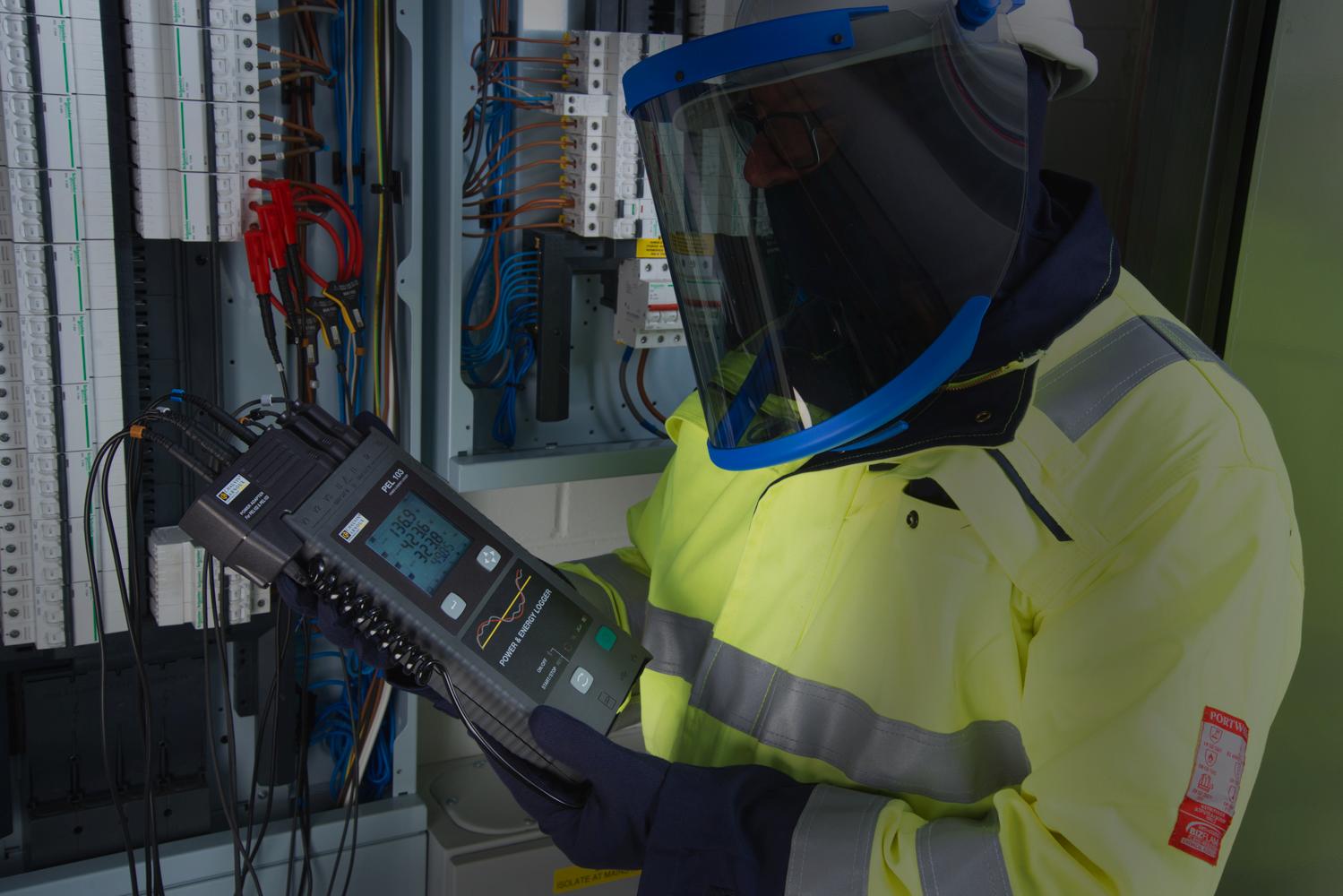







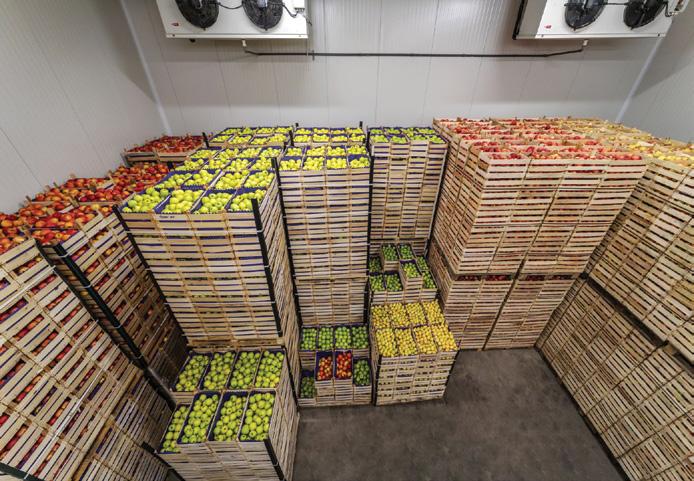


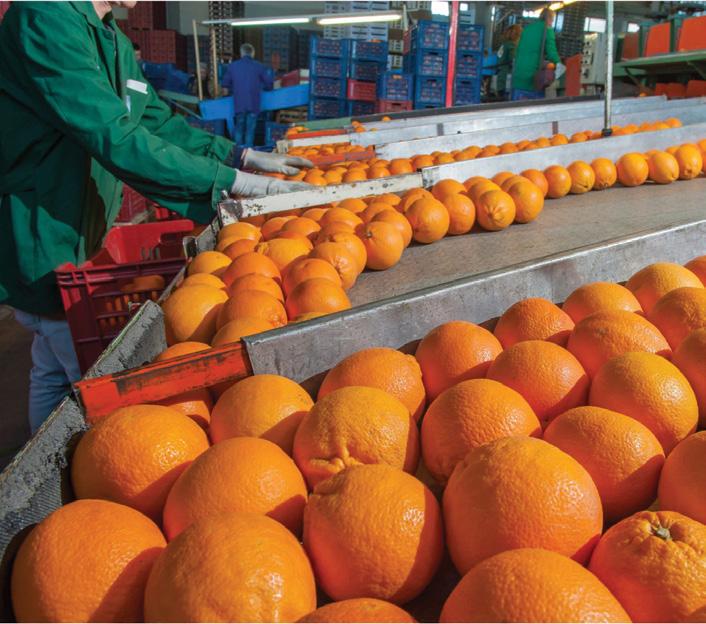
Though unaware of any specific issues relating to energy usage, the fruit processor felt that it would be good practice to identify the major users of energy in its factory, and to investigate opportunities for energy savings and efficiency improvements. The first step was to engage Smart Energy Solutions NI, an expert in energy efficiency, to inspect the production processes and, where possible, take manual readings from panel meters to provide an indication of energy usage. Discussions were also held with the factory operations manager to determine which items of equipment were likely to be the biggest energy users.

Even before energy prices started their recent almost exponential climb, businesses could cut their energy bills dramatically simply by analysing their energy usage and identifying opportunities for improvement. Following this approach, a major processor of fresh fruit cut its energy bills in half, as Julian Grant of Chauvin Arnoux explains.

The information gathered was used to develop a real-time cloud-based solution for continuously monitoring critical circuits, so that efforts to reduce energy usage could be accurately targeted on those areas where savings were most likely to be significant. Continuous monitoring would also allow the effect of energy efficiency measures to be assessed quickly and reliably, as well as making it possible to confirm the ongoing performance of those measures’ months and even years after they had been implemented.
As a preliminary part of this exercise, Chauvin Arnoux PEL103 power and energy loggers were fitted to the plant’s main power users and, almost immediately, these produced an interesting and concerning result: the refrigeration system on the main cold store was running continuously and was consuming energy costing £650 per week at the prices then prevailing. The cold store service provider was asked to check the installation and found that it was switched to manual override, possibly as a result of some earlier problem with the control system.
A new control system for the cold store, including an energy-efficient variable speed drive for the compressor, was installed, after which the energy performance was closely monitored for a period. This revealed that energy usage has dropped by more than half, to just £300 per week.
Installation of a full energy monitoring system subsequently went ahead, covering the incoming main supply, two cold stores, a deep chill store, three production lines and two compressors. The work, which was carried out by Smart Energy Solutions, involved network cabling, IT configuration, cabling to mains cable chamber, hard-wired current transformer connection, and the provision of a three-phase reference supply.
Tariffs were set up on a dashboard, and the fruit processor’s staff were given training and support to establish baseline data. They were also shown how to identify opportunities for energy saving by looking at historic data, and how to evaluate the effectiveness of energy saving measures by looking at before and after results.
One of the energy saving options that was investigated was voltage optimisation. For this, accurate measurements were again made with a Chauvin Arnoux PEL103 power and energy logger, which revealed lineto-neutral voltages of 239.5, 235 and
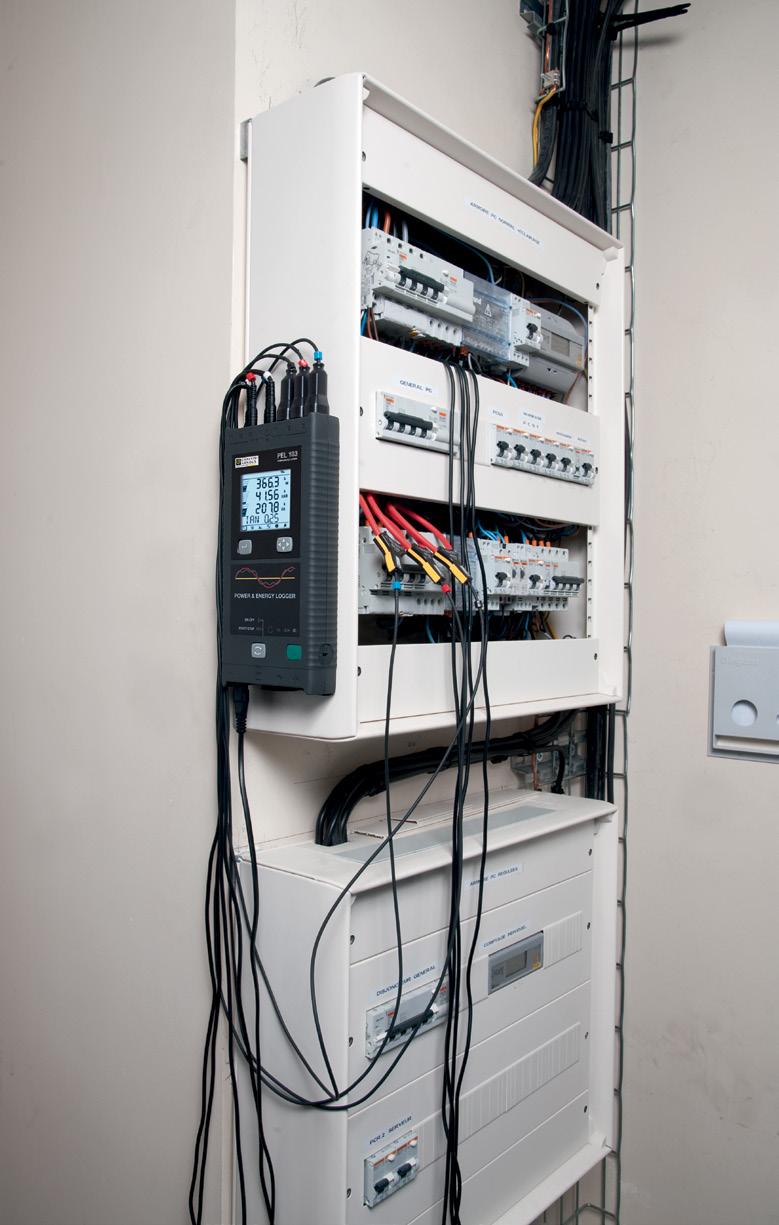
244V. Maximum import capacity was 204 kVA, and a comprehensive load analysis was conducted to determine which loads would deliver the biggest savings with voltage optimisation.
This work led to the installation of a 288 kVA voltage optimisation system, which was sized specifically to allow headroom for future expansion of the plant. Savings from this measure alone are predicted to be around 6% of the energy bill which means that, even before the recent large increases in energy prices, the voltage optimisation system would recover its costs in under three years.

Overall, with all of the energy savings taken together, including those delivered by the installation of a new control system for the main cold store, the end user expects to make savings equivalent to 50% of its former energy bills, which means that the payback period for the entire project is less than one year. Could other companies make similar savings? Almost certainly, but without accurate and reliable energy monitoring, they will never know! So, consider carefully, might it be worth your while to invest
www.chauvin-arnoux.co.uk
a little in analysing your energy usage, with the very real prospect of saving a lot?
As the latest iteration of the Public Sector Decarbonisation Scheme (PSDS) allocates £635m across the sector, many organisations are replacing out-dated fossil fuel heating systems with modern, sustainable, alternatives. Dr Alex Mardapittas, CEO at Powerstar, looks at the benefits of the ‘whole building’ approach at the heart of this latest round, and shows how local authority clients are already benefitting from greater energy efficiency and cost savings.
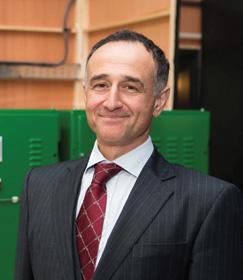
The UK’s building stock is among the least energy efficient in Europe with heating the biggest issue. Unsurprising, then, that the latest PSDS funding round is making old heating system replacement a mandatory component of any bid. That said, up to 58% of a PSDS grant application can be focused on energy efficiency as part of the overall proposal. Since the cheapest, and greenest, unit of energy is the one you don’t use, resilient energy management technology plays a vital part in any organisation’s roadmap to Net Zero –helping to reduce energy consumption; to better-manage onsite renewable power generation; to facilitate new revenue through grid balancing, and to keep vital services running during power disruptions. In the current energy crisis, two technologies – Voltage Optimisation (VO) and Battery Energy Storage Systems (BESS) – offer demonstrable benefits, addressing the critical issues of the Energy Trilemma: affordable, sustainable, and secure power supply.

When Copeland Borough Council in Cumbria approached Powerstar they had already identified voltage supply as an area of improvement and were looking for a reliable and secure system that would be highly efficient and provide demonstrable reductions to energy consumption, costs, and carbon emissions. While the UK and the EU regulate for mains supply voltage at

230V +10%/-6%, the permitted voltage range can be anywhere between 216 and 253V. The National Grid typically supplies higher than 230V, to ensure that supply meets legislative requirements, far higher than the 220V at which most electrical equipment is rated to operate within the UK. Working at a higher voltage not only leads to possible equipment damage, shortening the lifespan of business-critical equipment and leading to greater maintenance costs, but it also
means higher energy bills. Lowering the incoming voltage, through voltage optimisation (VO), reduces overall


electricity usage, and Powerstar have implemented this technology across more than 6,000 carbon reduction strategies for clients. VO technology has saved Copeland Borough Council 59,760 kWh a year, equivalent to 32.6 tonnes of carbon dioxide. Lowering incoming voltage reduces electricity consumption, saving on energy costs while also helping to decarbonise the organisation. As Former Councillor Allan Holliday, previous portfolio holder for the environment and sustainability at the Council, commented,

“The voltage regulation system is a great example of a change that we can make which helps the environment and saves money without any effect on the services we provide. By making this change, we can reduce the amount of energy we use in the building, yet still operate all of the same technology and systems that we currently use.”
In the current economic climate,
resilient power – uninterrupted supply –and budgetary constraints are the issues at the fore for every energy and facilities manager. In this context, Battery Energy Storage Systems (BESS) are a vital aspect of any strategy, bolstering energy security while offering the flexibility to maximise sustainable energy options and generate new revenue to help offset unexpected price increases. South Staffordshire Council’s requirements exemplify these dual priorities. The Council needed Uninterruptible Power Supply (UPS) but also wanted any investment to allow them to maximise income generation and ensure payback from their solar array – managing this green energy power for their own use while also bolstering income through the sale of energy generated on site to the Grid.
Powerstar installed a 250kW BESS, providing full UPS and enabling the Council to store excess solar-generated
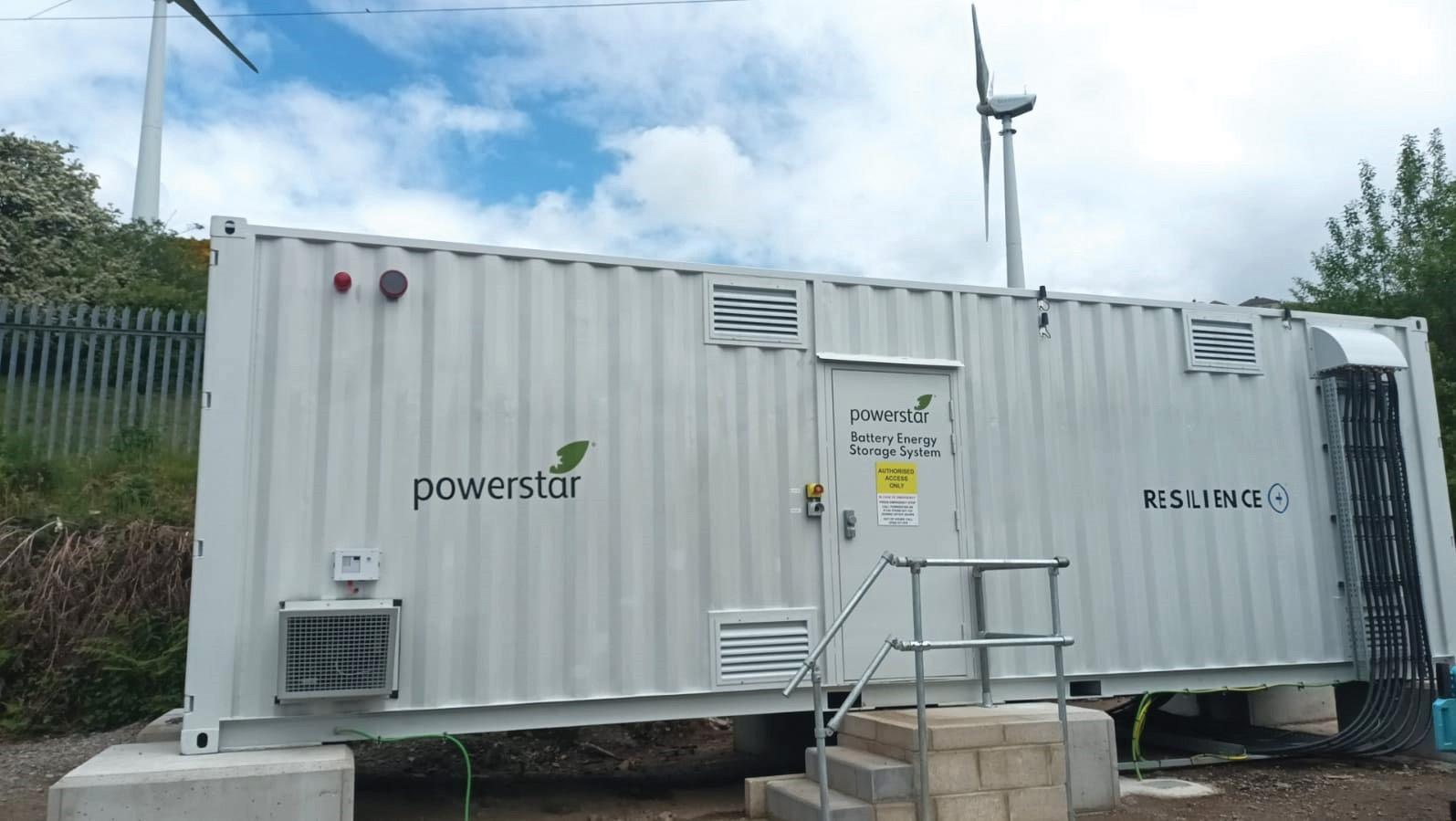
power and to then export this to the Grid, meaning additional revenue. Being able to store energy – whether drawn from the Grid at off-peak prices and stored to be used when needed, or whether generated on-site and stored for use at peak times – enables the Council to manage its energy budget in the most cost-effective manner. Similarly, control over storage and supply means that the Council can manage its export of power back to the Grid, which is critical to avoid exceeding their agreed export capacity, thus eliminating the risk of penalties. Crucially, in day-to-day operations, the BESS installation has protected the Council’s site from numerous blackouts, providing site-wide resilience for up to 2.5 hours at peak load. In one outage, a transient power cut for around three minutes, the full load for the site was supported by the BESS, keeping all electrical equipment functioning normally.
We are all looking towards Net Zero targets in the midst of an energy crisis. The three arms of the Energy Trilemma – sustainability, security, and affordability – are critical issues. In the context of a ‘whole building’ approach to energy management, the benefits of an energy strategy that incorporates modern power resilience, are clearer than ever before.
To see how Powerstar’s energy management technology could benefit your organisation, try our new energy saving calculator tool: https://powerstar. com/energy-saving-calculator/ W: www.powerstar.com T: 0333 230 1327 E: info@powerstar.com
From residential to commercial buildings, the UK’s built environment is responsible for 25% of the UK’s greenhouse gas emissions. Through its provision of buildings for millions of citizens accessing public services, the public sector plays a significant role in helping with the country’s Net Zero journey.
Energy efficiency and management in the heating and cooling of public buildings are crucial to the UK’s decarbonisation goals. Changes to how the public sector manages its estate have enormous potential to be a force for good.
Local authorities are prioritising Net Zero in response to the climate emergency. Yet the challenges of energy efficiency and heat decarbonisation cannot be underestimated. According to our research, upfront cost is the biggest obstacle to implementing net zero strategies. Additional barriers include: lack of inter-departmental and stakeholder coordination access to affordable and readily available energy efficiency technologies
• limited capacity and experience
• insufficient information about their existing energy performance

Energy efficiency projects represent an investment opportunity for local authorities, but knowing where to start can be difficult. Many of the buildings needed in 2050 are already built, so retrofitting and decarbonising the buildings you’ll be using for decades is a good place to begin.
• Take a ‘whole building’ approach. Heat decarbonisation
combines low-carbon heating system upgrades with energy efficiency measures; the solutions are interlinked.
• Understand your data. Do you know where your primary energy consumption is coming from? After you understand where you are wasting energy, the changes you implement will be more effective.

• Conduct an energy audit. An audit can help you understand what energy efficiency improvements will deliver more impact. Using the data you collect and the results from your audit can highlight potential areas for improvement, helping you prioritise.
• Write an action plan based on your priorities. Use your action plan to allocate resources and timing to implement improvements to the building.
You can then identify short, medium and long-term actions, including:
Lighting accounts for nearly 5% of global CO2 emissions. A global switch to energy-efficient light-emitting diode (LED) technology could save over 1,400 million tonnes of CO2 and avoid the construction of 1,250 power stations.
With savings of up to 50 to 70%, LED lighting is recognised as one of the most actionable and ready-to-implement technologies for cities to transition to a low carbon economy and peak emissions.
One option for local authorities
to consider is a heat network. A heat network, sometimes called district heating, is a distribution system of insulated pipes that takes heat from a central source and delivers it to a number of domestic or non-domestic buildings. Heat networks allow you to exploit larger-scale – and often lower cost – renewable and recovered heat sources that otherwise cannot be used.
Installing heat pumps can also help reduce carbon emissions, allowing you to save money on heating bills by replacing older, less efficient boilers. However, heat pumps can increase electricity demand. So, factor it into your business case and financial forecast.
Local governments can dramatically reduce their carbon footprint by purchasing or directly generating electricity from clean, renewable sources. Options include generating renewable energy on-site through solar panels on a municipal building and purchasing green power through power purchasing agreements. In addition, securing a longer-term renewable power supply contract at a fixed price can offer more certainty in power costs and origin.
Central and local government

organisations can integrate advanced technology solutions into operations, ecosystems, and maintenance regimes.
Introducing IoT solutions that use sensor data is a cost-effective way to tackle energy inefficiencies from heating to lighting. In addition, designing and deploying automation into systems, buildings management, operations, and ecosystems at scale can enhance capacity while helping building managers focus on more complex operational processes.
Energy efficiency retrofitting allows you to upgrade the energy performance of public sector buildings for their ongoing life. Energy efficiency retrofits
help reduce operational costs, particularly in older buildings, by improving insulation, water efficiency and heating, ventilation and air conditioning systems.
Crown Commercial Service offers ‘end-to-end’ solutions to help with decarbonisation initiatives plus innovative funding options to tackle upfront costs.
Our twin-agreement solution consists of a framework for accessing specialist Asset Finance advisors and a funding platform through the Leasing and Loans Dynamic Purchasing System. We also maintain a list of CNZ grants. https://www.crowncommercial.gov.uk/

As UK businesses battle to keep the lights on and make headway on climate change goals, we have a fresh opportunity to seize the full potential of energy efficiency. It has long been recognised as the mainstay in building the low carbon economy of tomorrow. But despite the potential, the sluggish pace of progress and poor public awareness of the benefits across our built environment is leaving us playing catch up on climate change goals and exposing us to soaring energy bills in the process.
The urgency cannot be overstated but there are fresh concerns that energy efficiency is taking a back seat. The government’s new support package for businesses will see gas and electricity prices fixed for six months, providing a short-term safety net, but questions arise around what further longer-term reforms are needed to seize the energy efficiency opportunity and drive down costs.
A new thinktank report by the Institute for Government sets out the scale of the challenge. It finds that the UK’s buildings are among the least efficient in Europe. These findings make a loud and clear point that a robust long-term plan tackling the underlying issues is critical and “could deliver significant savings within a year.”
But the onus to take action doesn’t just rest on the government. It relies on business leaders, facilities managers, and individuals like us to make the buildings we inhabit much more efficient. The evidence is clear, as commercial buildings use around 40% of global energy, emitting nearly a third of the world’s greenhouse gases. As commitments to sustainability are encouraged through both policies
and public opinion, businesses may be put at a disadvantage regarding talent, incentives and profits if they fail to make their buildings more efficient. This begs the question – how can businesses improve efficiency without investing millions or harming workforce productivity?
At first glance, ‘energy-efficient technology’ might seem like an oxymoron. After all, when we think of the relationship between technology and energy, we often picture large commercial city landscapes fully illuminated deep into the night, or rows of office PCs and screens consuming power for up to 12 hours a day. But in recent years, technology that is truly energy-efficient has advanced far beyond incremental changes.
Now, businesses can employ various optimisation software platforms to predict and directly monitor workplace energy costs, and automatically optimise cooling, heating, and power generation. They can use AI-powered data analytics to monitor building performance, enhance tenant experience, and meet sustainability goals. Building managers may still assume that the implementation of such powerful, energy-efficient technologies would be a long, costly process. But the truth is they can be installed into buildings quickly and efficiently, and managers can start seeing results and returns immediately.

What if you could predict the future? And better yet, what if your central
plant could automatically adjust your energy usage and costs to prepare for that future? Meet central plant optimisation software. Central utility plant (CUP) technology uses predictive algorithms to maximise buildings’ energy efficiency, reducing greenhouse gas emissions while delivering reliable utility services. And it dispatches decisions every 15 minutes based on a myriad of ever-changing inputs.
First, it looks at equipment performance models. Every major piece of building equipment, such as chillers, boilers, and cooling towers, is tuned into the system to monitor performance and cost, and optimise efficiency under operating conditions. Next, it pulls seven-day local weather forecasts for temperature, humidity, and cloudiness to predict loads, equipment performance and ambient conditions. For example, if a particularly mild Wednesday was predicted, CUP technology would prepare to reduce the building’s heating output, ensuring the central plant runs at the lowest possible cost, and far more sustainably, too.
Then, the software combines the forecasts with existing data on historical loads, days of the week, time of day, building schedules, maintenance calendars, and special events to adjust operations and automatically make decisions that guarantee the reliable delivery of workplace utility services. CUP software can also model the simplest flat rates to the most complex real-time pricing and market-based incentive programmes. So, even in the event of high demand, such as the current UK energy crisis, buildings and occupants using CUP technology enjoy lower tariffs, optimised efficiency, and retain a much larger utility budget.
Installing comprehensive building management platforms are another way that businesses can achieve energy efficiency. These AI platforms give managers a virtual birds-eye view of buildings and inform decision-making that delivers stronger sustainability practices. They constantly scan workplaces, pinpointing inefficiencies, diagnosing equipment problems, and advocating the corrective action needed to fix them. They also enable managers to monitor not only energy usage, but also assets, space, health, and occupant comfort parameters, all to improve Environmental, Social and Governance (ESG) scores.
Many platforms even offer an eco-system of cloud-based apps, which enable managers and tenants to instantly adjust heating, water supply, HVAC systems and more in different areas of a building. These self-

service apps also mean managers can monitor real-time spending, efficiency insights, and progress straight from their smartphone, helping regularly update stakeholders on sustainability results. So, they’re not just gathering data – they can share it, too.
Thousands of buildings worldwide have already installed smart interconnected management platforms. These enterprise management tools are used to enhance the comfort of all occupants, by monitoring and improving energy efficiency, tenant satisfaction, asset performance, and maintenance operations, and space performance. They are designed for facilities including commercial offices, healthcare, mixed use high-end, transportation, retail, and school systems.
If best practices are adopted worldwide, businesses can achieve their individual journeys towards reaching net-zero carbon emissions, while

helping the planet for all. As bills soar and businesses grapple with multiple goals, technology offers a wholly improved way of managing utilities. Without smart tech we can’t hope to make impactful changes for themselves, the environment, and our health.
Legacy infrastructure and gas heating within buildings can also be a huge barrier to reaching the government’s net zero goals by 2030. Improved technology can range from the local to the global, such as switching from gas boilers to air source heat pumps, installing solar panels and implementing LED transformation. As a result, carbon emissions will drop, and this reduction in energy use can translate to a 50% reduction in cost, with on-site energy production and the use of LEDs able to offset the increase in electricity use. With millions of us facing fresh energy pain and climate change pressures mounting, there’s never been a better incentive to walk the walk.
https://www.johnsoncontrols.com/

The rapid rise in energy costs over recent months is concerning for businesses of all sizes across all sectors of the UK economy. The announcement of the Energy Bill Relief Scheme in September was a welcome lifeline, but the reality is bills will continue to be far higher for the foreseeable future than they were at the start of this year.
In this quick guide we explain the Energy Bill Relief Scheme, how it will impact businesses, and what other steps businesses can take to bring down their energy costs.
The scheme is a governmentbacked discount on energy prices for non-domestic energy users, which works in a very similar way to the Energy Price Guarantee for domestic consumers. The scheme applies to businesses, voluntary sector organisations such as charities, and public sector organisations such as schools and hospitals who are on certain fixed price contracts, deemed or variable tariffs, or flexible purchase contracts.
It is important to understand that, despite the scheme being widely described as a “price cap”, it does not actually cap the monthly bills a business will pay. Instead, the government will provide a discount on the wholesale element of gas and electricity unit prices, which means that component of the bill will be lower than it would otherwise have been (but not necessarily reduced to 2021 levels). However, the total amount of the bill will still depend on the business’s actual
usage and other costs such as network charges, which can vary year to year.
Energy suppliers will automatically apply the discounts to the bills of all eligible business customers.

Having a proper energy procurement strategy can pay dividends.
Procuring your energy supply contracts through brokers or third party intermediaries (TPIs) won’t necessarily lower your energy bills, because commissions (paid by energy suppliers to brokers/TPIs) are often built into the supply contracts (i.e. passed on to you, the customer). If you use a broker or TPI, ask them for a detailed breakdown of costs and charges, including any commissions, so you understand exactly how much you are paying for your energy and other mandatory charges (e.g. network charges), and how much is commission.
Commission may be payable on each unit of energy supplied over the entire term of your supply contract, in which case it may be significantly cheaper to simply pay your broker/ TPI a one-off fee for advice and/or for procuring quotes on your behalf. You can also approach energy suppliers direct to compare costs and avoid brokerage fees/commissions altogether.
If you buy green electricity, it is also worth checking what you are buying is genuinely green (sourced by your energy supplier from renewable generators), or merely brown power (non-renewable), with green certificates stapled to it. In the latter case you may
be paying a green premium for electricity which isn’t truly green.
Businesses should seek to couple a strong energy procurement strategy with measures to improve energy efficiency, particularly in relation to heating and lighting. The Energy Savings Opportunity Scheme (ESOS) already requires large organisations to undertake a mandatory assessment of their energy usage every four years and to identify new ways of saving energy; however, more frequent assessments, coupled with swift and robust mitigatory action, could yield significant cost savings for businesses.
Additionally, businesses should not underestimate the potential savings which could be made by demand reduction at the individual premises level, for example through:
• office/building managers regularly conducting housekeeping walks to identify opportunities for energy savings (such as shutting windows, turning off lights, unplugging electrical devices), reporting maintenance issues and ensuring swift resolution, and identifying any unfavourable staff behaviour; and
• ensuring employees are actively engaged in reducing energy usage by issuing regular communications in relation to problematic behaviours such as leaving doors open during heating season or leaving lights, computers and photocopiers switched on.
Reliance on electricity from the grid (and exposure to increasing wholesale
market prices and volatility) could be reduced or avoided altogether through the installation of generation assets on your site – ideally lower carbon/higher efficiency assets such as solar panels, heat pumps, battery energy storage systems (BESS) or combined heat and power (CHP) plant. The upfront costs of these types of assets are continuing to fall, although the overall cost of installation will vary depending on the type and size of asset selected.
For businesses looking to avoid upfront capex, third party funding is an option. Typically this would involve the third party financing, procuring and installing the equipment and then potentially operating and maintaining it thereafter. The third party would typically recoup its expenditure by charging the business for the generated energy through a power purchase agreement (PPA). The price for electricity supplied via such a PPA tends to be lower than grid, and the term of the PPA can be fairly long (often between 5 and 15 years) thereby fixing the price and insulating the business from wholesale price volatility.
On-site energy generation also serves to enhance security of supply.
If a business does not have suitable space for installation of onsite generation assets, it can seek to buy energy direct from a generator via a corporate PPA. This is becoming
increasingly popular in the renewable energy market where businesses buy electricity direct from solar farms or wind farms, thereby securing fixed price energy over a relatively long term (in the same way as onsite PPAs) and also bolstering their ESG credentials by buying green.
Sometimes the electricity is supplied directly from generator to consumer via a private wire (i.e. a privately-owned cable physically linking the two) but where that’s not possible, it can also be supplied via the grid using a sleeving arrangement. The business consumer still benefits from fixed price green electricity.
Businesses can also make (as well as save) money by reducing their energy demand or otherwise providing flexibility to the grid. For example, if a business can turn down its energy demand for a period of time (even a few minutes) when asked to do so by National Grid, it can receive a revenue via a service called Demand Side Response (DSR). DSR and similar flexibility services help National Grid to manage supply and demand on the national electricity system, for instance when there is particularly high demand (the classic example is half time of the FA Cup final when many people around the country switch on their kettles at the same time) or a large generator unexpectedly goes offline leading to a shortfall in supply.
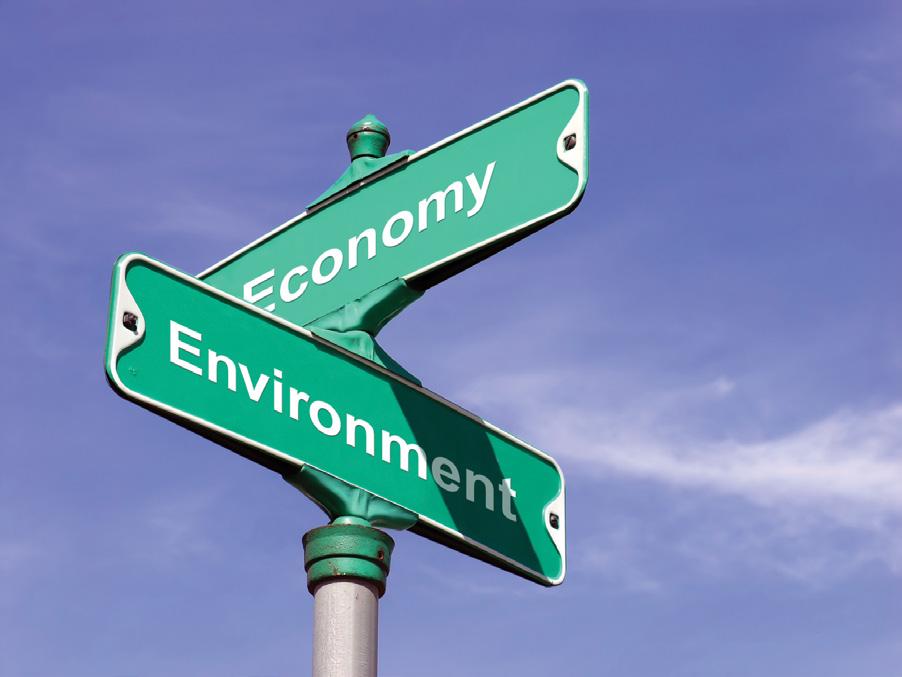


In a similar way, any business which operates electric vehicles can use the vehicle batteries to provide flexibility services to National Grid when the vehicles themselves are not in use – for example, where fleets of light commercial vehicles are plugged in overnight and are not required until morning. A special bi-directional charger is required, but otherwise the process is relatively simple. It is known as vehicle-to-grid or V2G and, again, is a paid-for service.
Some businesses receive their hot water and/or space heating via a district heat network (rather than generating their own heat using a gas boiler). This can come with the benefit of fixed price heat (in much the same way as on-site/corporate PPAs offer fixed price electricity) and can also be more efficient than conventional heating.
Energy users connected to district heat networks cannot directly benefit from the government-backed discounts mentioned above, although the government has asked heat network operators to pass any benefit on to their customers. However, unless/until this is mandated, we recommend that district heat customers engage with their providers and review their heat supply agreements to determine whether there is any contractual requirement for savings to be passed on. www.freeths.co.uk
In today’s climate, the energy industry is changing so frequently and there is a lot of uncertainty around energy pricing.
recording your businesses energy data, to ensure you are not paying more than you should on your bills. Here, SystemsLink explore the best ways
Energy data compromises of your business’ gas, power, and water consumption, which once collected, can be used to provide you with better insights into your energy consumption.
According to Forbes poor data quality can be responsible for an average of $15 million per year in losses. 60% of those surveyed didn’t know how much bad data can cost their business, because they didn’t measure it in the first place.
Ensuring that you are providing accurate data to your suppliers will help to define more accurate billing and will enable you to refer and obtain as evidence when needed. Data is so important and when it is recorded incorrectly, businesses can have a hard time correcting it, meaning they overpay on their energy usage.
With businesses facing increased pressure from customers, the supply chain, and investors as well as the government to decarbonise, how can they use their energy data to meet the UK’s 2050 net zero goal?
An EMS is simply a software system for any energy consumer, used by specialist energy operators to help manage your data and energy usage effectively.
The benefits are extremely useful if you have a business as it helps monitor and analyse your utilities. Monitoring and Targeting allows easy identification of waste or overspend and allows savings
to be tracked. An EMS is an essential energy software for your business.

What we do now will have a huge impact on what happens to planet earth in years to come and what future generations will experience. We all need to work together to reduce our Greenhouse Gas emissions (GHG) for our goal of reaching net zero to be successful.
There are many benefits to managing your energy better. Not only is it better for your business economically, but it also helps your business to meet its voluntary and compulsory commitments such as the Streamlined Energy and Carbon Reporting (SECR) framework, as well as helping to reduce operational costs, supporting brand image, and increasing workplace happiness.
Firstly, you need to understand and measure your business’ carbon emissions to create a baseline of data that you can measure any progress from. You’ll then need to set a target for your business to take positive steps towards climate action with Science based targets.
Then it’s time to start planning what your business can do to make changes and reach its Science Based Targets initiative (SBTi’s) to support the UK’s net zero goal.
THERE ARE MANY WAYS YOUR BUSINESS CAN USE DATA TO MANAGE ITS ENERGY USAGE AND GET TO NET ZERO FASTER.
• Log Automatic Meter Readings (AMR) to gather half hourly (HH) data within
your company and keep track of any changes throughout each month
Install a Smart Meter with your preferred supplier to obtain accurate billing
Reduce your carbon footprint where possible. Switch off, lighting, heating, printers, microwaves, and vending machines
• Analyse your billing so you’re able to identify any spikes in energy usage
• Reconsider your energy supplier to get the best deal
• Don’t fill the kettle too full when making your colleagues a brew if it isn’t needed, as this requires extra heat!
• Install LED lighting in work rooms
– LED lights use less energy than incandescent lighting
Switch off everything at night before leaving the office
Track your data automation to make the most of your data
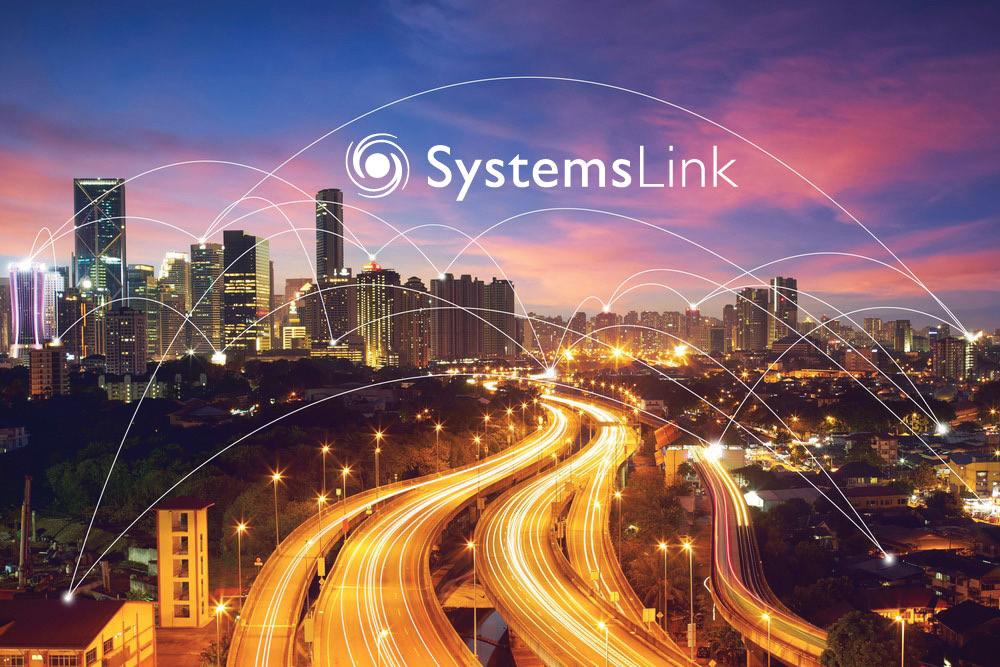
YOUR ENERGY TO MEET NET ZERO?
Implementing small changes can have a massive impact over time and ultimately reducing your businesses energy consumption, has a positive effect on your carbon footprint. Having a substantial energy strategy in place can make the process so much easier. Get in touch with our experts at sales@systems-link.com or visit our website to see how we can help your business reduce its emissions; http://www.systems-link.com
Which is why it is essential to stay on top of
to control your business’ energy costs.
As the energy crisis continues in the UK, attention is turning to how businesses can save on their energy usage, both for the environment and for their expenditure. Additionally, with Gen-Z entering the working world with full force, focusing efforts on to ESG targets has never been more important, with 43 per cent of Gen-Z workers stating that a company’s mission, purpose and values are essential for them when choosing an employer.

A recent report from BRITA found that by targeting sources of invisible waste, which includes equipment being left on needlessly overnight such as printers, computers, or air conditioners, businesses will be able to cut their energy levels significantly. 45 per cent of business leaders admit to leaving this type of electronic equipment on overnight, with 65 per cent not even knowing how much energy they are using. It is vital that companies consider how much energy they use and identify ways in which they can reduce this to make energy management strategy decisions.
Computer-aided-facilities-management (CAFM) systems can provide detailed insight into energy usage, and solutions to reduce it. A CAFM system can already unlock a number of time and cost benefits relating to asset and maintenance management through streamlining workloads and supporting data-driven decisions. This software can monitor energy usage across a building, providing a detailed picture of several areas where inefficiency can be tackled.
One way to access this type of data is by integrating sensors across your building. Sensors allow CAFM systems to log the occupancy of rooms and other areas of a building. This data can be used
to inform strategies around lighting, air conditioning and cleaning, and can even synchronise with room booking software or a building management system (BMS) so that only areas that need be lit, heated and cleaned are done so ahead of time.
This eliminates energy waste such as lights being left on in meeting rooms, or computer systems being left on standby unnecessarily.
It is addressing these several small changes that combine together to create a substantial impact. The Carbon Trust calculations on the issue shows that a 20 per cent reduction in energy costs for a business can equate to a 5 per cent increase in sales for many firms. It is because of this that many facilities management companies are taking on more responsibility to provide good energy management solutions on top of the expected high levels of service.
Another helpful way that CAFM can reduce energy costs is through greater organisation of asset maintenance. Optimising cleaning schedules, for example, is a great place to start. CAFM systems allow users to mark which areas need cleaning. When a meeting room has been used, it should be cleaned before its next use. Rather than having a schedule whereby the rooms are all cleaned at a specific time, users can tell the system after a room has been used which alerts the operative in real time or in advance that this room needs to be seen to. Alternatively, room booking systems can automatically flag when a meeting is over, and the room needs to be cleaned.
This way, cleaning teams are much more efficient, which saves on energy costs and reduces waste as fewer cleaning products are used and cleaning
run as regularly. Optimising assets also reduces the need for emergency call outs. Office devices such as printers, scanners, computers, and monitor displays are “vampire devices” – they consume energy while in standby mode. Turning them completely off when not in use is a good place to start, but ensuring their efficiency is another great way to keep energy costs down. A CAFM system can store data about a device’s last maintenance checks, warranties and condition. This insight helps to ensure that appliances are less likely to malfunction or cause issues, meaning their energy usage is at its most efficient. Well maintained assets draw on less energy and managing them to these levels of intricacy can lead to significant savings over the course of a year.
Data taken from a BMS is only as effective as how it is used. It is important to work closely with vendors to identify the type of data required to help make cost savings and how best to organise it.
Identify the metrics that you wish to track, and how these relate to your organisation’s KPIs and sustainability commitments. Reports and dashboards can be built within the CAFM software to track this information, providing intelligent insight into where energy savings can be made.
A BMS cannot turn appliances off for you, but the data collected can help to advise facilities managers. With the looming threat of potential blackouts and further energy rationing, taking these steps to reduce energy usage through the use of integrated software will see great benefits to the business as well as the environment. https://www.swg.com/

Gary Watkins of Service Works Global discusses how the use of building management systems combined with computer-aided-facilities-management will help businesses bring down their energy usage, benefitting business costs and aligning with ESG principles.
Shortages of natural gas mean the possibility of winter blackouts across Europe have become a real prospect. With supply chains already stretched and facing a challenging winter, attention will turn to how organisations can better preserve energy and futureproof processes should fuel shortages become commonplace. Here, Simon Emeny, Director – Specialist Markets, Inspection Services at LRQA explains how auditing and inspection services can help reduce the impact of such prevalent fuel shortages on a plethora of manufacturers and processors.
The energy crisis is quickly becoming one of the most important business focuses across Europe. Blackouts and planned power cuts are becoming a real possibility in many regions, with energy supplies being severely impacted by the Russia-Ukraine war.

The potential gas cut-off from Russia has been estimated at 50bcm (billion cubic meters of natural gas), yet the International Energy Alliance (IEA) has recently estimated that over 50bcm of gas is wasted through leaks, flaring and venting across the EU. In the UK, meanwhile, it has been estimated that around £33.9bn of gas will be wasted in 2022. With the price of energy having a detrimental impact on operating costs, better management of oil and gas and forward-thinking energy strategies are therefore going to be more crucial than ever to ensure the security of the fuel supply into a given process is as protected as it can be.
A number of initiatives have already been announced across Europe to help minimise the impact of rising energy prices. The European Commission, for example, has recommended using energy monitoring and control tools, along with energy audits, to highlight where businesses can improve efficiencies. In the UK, energy regulator Ofgem is proposing initiatives to promote efficiency measures. It is clear that change is required, but implementing
a successful strategy in such pressured environments is a challenge in itself.
With wasted gas and energy arguably more costly than ever, attention needs to turn on how organisations around the globe can reduce energy consumption. This needs to be a focus across all commercial and industrial space occupied, with some facilities – and equipment – not being fit for purpose.
Of course, introducing ways to reduce energy waste is not only important for the immediate future. Given the long-term ambitions to reduce global emissions, being alert to environmentally damaging leaks and flaring will have wider benefits beyond the current energy crisis.
How, then, can businesses reduce energy consumption successfully? First, it’s important to understand where energy is unknowingly being wasted across the entire supply chain. While this is not always immediately clear to the untrained eye, embracing inspection services can play a key role. Secondly, organisations should look at putting steps in place towards a transition to cleaner energy. Again, auditing is an integral part of this journey.
Introducing a third-party audit strategy is one way to help businesses identify areas of potential improvement. Audits can help understand the risks facing companies, both
internally and externally, equipping them with the information needed to reduce energy waste and eventually transition to a greener future.
In the short term, they provide opportunities for businesses to better manage their energy use, such as ensuring equipment is fit for purpose. Audits will uncover whether equipment is compliant with the latest regulations and expectations, helping to build confidence that projects and processes will run smoothly.
Ensuring supplier equipment is also up to the expected standard is also important, yet this is not always easy. Here, vendor audits and site inspections are essential to ensure the wider supply chain is meeting requirements. Through site inspections and audits, a wider programme can be created to ensure standards are not only met, but also maintained.
Longer term, organisations should be looking to transition to cleaner, more renewable energy sources. ESG (Environmental, Social and Governance) strategies are going to become increasingly important to ensure this transition is smooth. Audits and inspection services will again play a critical role here, ensuring businesses comply with complex global and local regulations.
With new technologies come new challenges, meaning organisations should also think about training for various codes and standards. Whether its refresher courses for more experiences team members, or complete learning solutions, providing training across the business can help improve efficiencies and futureproof organisations.
The energy crisis is becoming a defining moment of the 2020s. With an immediate need to conserve energy – and a longer requirement to consider alternative energy sources – organisations are facing a plethora of challenges. It is clear auditing and training will have an important role to play and organisations should look towards the support of assurance, certification and inspection service specialists, like LRQA.
Not only can audits and training support short-term requirements but they will also play a key role in ensuring the transition to greener energy is a success.
For more information on inspection services, visit LRQA.com
In these environments, data gathered from sensors can be streamed seamlessly to the cloud, with this information being used to improve performance, boost efficiency, and increase reliability.
For steam systems, rapid advances in digitalization and the growth of the Internet of Things makes this kind of innovation and efficiency available today. Paired with steam technology, it holds the key to a sustainability revolution in industry.

It is already possible to make steam systems highly efficient. But new approaches are going to help make steam a truly zero carbon technology. Boilers can be powered by electricity, for example, which can be provided by renewable generation such as wind or solar power. Electric steam generators can convert renewable electricity into steam at 97% energy conversion efficiency.1
Green hydrogen, created without carbon emissions, is another option to power steam boilers.
All of these alternatives could help organizations decarbonize their steam production. And it’s all achievable at a surprisingly realistic level of investment, with re-use of existing equipment eliminating the need to put in costly new infrastructure.
But in order to quantify the return in these updates, demonstrate improvements to stakeholders and ensure the systems are living up to their full potential, there is another piece of the puzzle.
Advances in digital technologies are enabling industrial plants to be monitored more closely than ever before and provide better visibility of asset performance. Sensors are affordable, compact and low-power, and often include the wireless connectivity needed to send their data back to
1
https://www.anu.edu.au/news/all-news/ anu-scientists-set-solar-thermal-record
a central server. Once this data is obtained, it can be processed locally, or sent to the cloud for analysis.
The data gathered from steam systems, such as from flowmeters, control valves, steam traps and heat exchangers means that relevant key performance indicators (KPIs) can be set. This will help the systems to deliver even greater efficiencies over the longer term.
This data is also invaluable to monitor equipment for any problems. By spotting issues early, there’s an opportunity for preventative maintenance, before any more severe issues might arise. This helps to minimize downtime, which can often be prohibitively expensive in large production plants. Preventative maintenance can also help reduce any leaks, thus reducing the demand for steam.
Digital solutions mean it is easier for steam systems to be integrated into larger platforms. Data from the steam systems gives full visibility to decision-makers and enables different solutions to be used depending on what is best at any particular time – for example, choosing when to generate and use steam in response to excess electricity available from solar cells.
Data can also enable better management of the condensate water in the system, and the steam traps used to remove it for return to the boiler. Condensate typically contains about 25 per cent of the usable energy of the steam from which it came2. Returning this to the boiler feed tank can save thousands
2 https://www.spiraxsarco.com/global/ en-GB/news/on-the-road-to-a-greenerfuture
of pounds per year in energy alone. It also reduces the need for fresh replacement water, while saving money by cutting the requirement for costly chemicals to treat raw water.
For example, Spirax Sarco carried out a project at an oil refinery that delivered energy savings of £100,000 within 12 months, simply by identifying and replacing steam traps that had failed.
Overall, digitalization and the data insights it provides can be used to further enhance the efficiency and sustainability of steam systems. As organizations push to reduce their carbon emissions to the bare minimum, all of these improvements are significant part of the journey.
One of the biggest technology trends right now is the growth of artificial intelligence (AI). In industry, AI systems can create new opportunities for automation, providing the decision-making that would previously have been impossible with conventional IT systems. Eventually, AI may enable the deployment of fully autonomous steam systems, which calibrate themselves in real-time to improve productivity and boost efficiency. There is a growing trend towards running AI algorithms on ‘edge’ processors on or near the factory floor, instead of shipping data off to the cloud, which speeds up the response to inputs – and could help make such autonomous systems a practical reality.
Right now, steam stands at a point of tremendous innovation. It can play a central role in the broader context of the climate emergency and can provide exciting opportunities for existing and next-generation technical talent who want to deliver environmental change.
Download the ebook to powering a more sustainable future at https://ebooks. spiraxsarco.com/view/560648702/ E: hello@uk.spiraxsarco.com T: 01242 521361 W: www.natural-technology.com

The Mount Oswald student accommodation site at Durham University serves John Snow College and the brand-new South College. The purposebuilt facility provides rooms for 1000 students and offers accommodation, common rooms, welfare facilities and café bars. There is a new University Hub with a 300-seat events hall and music practice rooms. The Colleges share a gym, a launderette, a faith and quiet room, a dance studio, performance practice space and a multi-use games area.
Work began on the project site in 2018. The project’s value at the time was circa £75M and it is let under a 50 year PPP. The Joint Venture Partnership of Campus Living Villages, Equitix and Interserve submitted the winning bid.
Evaluating the capital cost, running cost and service cost of any proposed solution was fundamental to the viability of the bid. BSAP Ltd. was appointed to produce a design concept for building services within the scheme.
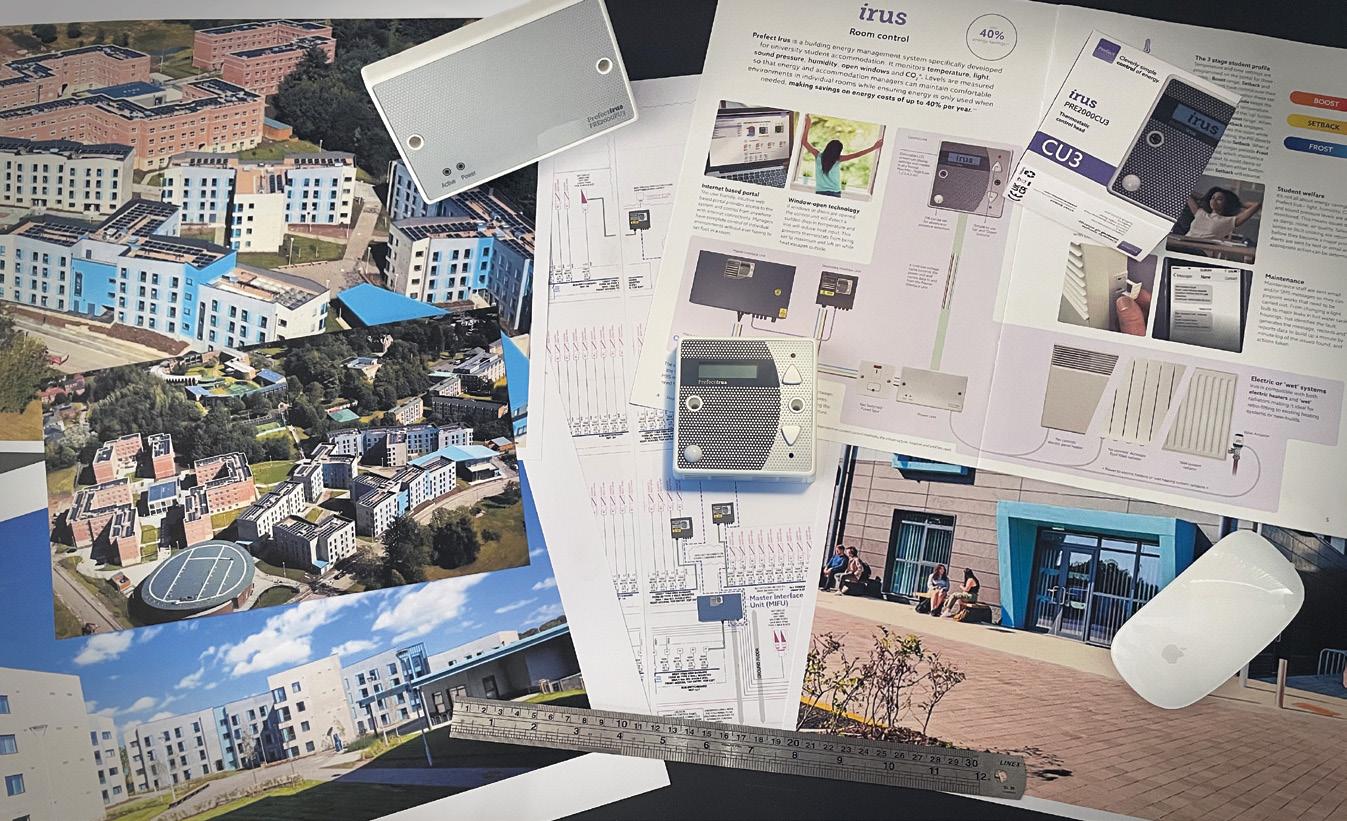
Martyn Harrison of BSAP explains, “Our philosophy is fabric first – making the building thermally efficient. Our DNA is trying to get away with as few building services as we can. Being instrumental in the early stages of the design process is so important in ensuring that building services are not an add on, but fundamental to the architect’s scheme. As a small consultancy with accomplished partners, we are very hands-on, we provide the voice of experience whenever we embark on a project”
He continues, “The biggest challenge we face is incorporating best practice solutions while making the project affordable. Recognising that there is an affordability issue in everything we do is key in arriving at the right design. BSAP is unusual in that we have a lot of cost planning experience aligned with design. Having designers sitting in this costing environment allows us to bounce our ideas around and ask the questions at the start; is this affordable or would another idea be better in this set of circumstances? How does new legislation affect the project? Are we exposing a
client to undue pressure? Will this design make a client vulnerable? Will the re-sell of the building be compromised?”.
Where appropriate, BSAP will advocate an all-electric system and this was the case with Mount Oswald – he explains, “Some initial concepts had been put forward before the contract was awarded. One of them involved a district heating network because Durham [University] has experience of this around its estate and there was quite a strong desire to go down that route. However, we didn’t feel that was the right solution because a lot of energy is used to heat and pump medium temperature or LTHW (Low Temperature Hot water) through huge distribution networks. It is a costly exercise, with pumps and boilers working all the time. It is heating the whole system, not just the demand that is there. That is really energy inefficient. There is system loss too. The whole point is that it isn’t cost effective, both in capital expense (CAPEX) and operational cost (OPEX) terms. The question has to be asked, ‘What is the point of this infrastructure if there isn’t a heating load within the building?’”

“Effectively there is this massive inertia in general distribution networks that is a significant cost – just for showering! That is where we pin-pointed the energy efficiency issue. In our opinion a better solution was electrical heating. If the building is thermally efficient, then the
load is hot water – it isn’t predominantly the space heating! This negates the need for a massively expensive to install and maintain general distribution network.”
To control the electric heating BSAP researched what was available. During conversations with student accommodation providers, they noted that Prefect Irus was mentioned numerous times. The simplicity and cost effectiveness of Irus was a big draw.
“We were sold on it primarily due to its compliance with reducing carbon use; energy efficiency in terms of only using heat when it is needed; and it is a very competitive CAPEX/ OPEX. A lot of the big schemes are looking at a 50-year lifespan – meaning replacement of all the infrastructure of the building services at years 20-25.”
In fact, BSAP were so impressed with Irus that they have installed a small-scale system in their new offices in York. Martyn explains “You would expect a building services company to have air conditioning, but we chose not to, we have destratification fans, we have a lot of air movement, we open the windows for ventilation, and we have electric panel heaters as our solution, these are controlled by Irus. The central control is a real plus, monitoring and controllability is easy. We felt that if we are recommending a system, we ought to put our money where our mouth is!” www.prefectcontrols.com
Across the UK and the rest of Europe, energy costs are soaring. Although there is short-term respite through the Energy Bill Relief Scheme, the cost impacts for public sector organisations exiting their current fixed-term energy supply deals are eye-watering, while there is no certainty of support after April.
At the same time, the public sector has set itself challenging targets to reach net zero – a crucial element of which is decarbonising heat. The Government’s £2.4bn Public Sector Decarbonisation Scheme barely scratches the surface.
However, the immediate challenge for most right now is mitigating crippling energy cost increases; coupled with almost unprecedented inflationary cost pressures for maintenance and planned capital upgrade programmes. All of which leaves little in the pot to “save the planet”.
A thread that binds both of these issues when it comes to heating buildings is the Performance Gap.
In short, this is the difference between how a system actually performs in real life; versus how it should optimally perform – measured across a range of metrics, including energy costs; carbon emissions; occupant comfort.
Eradicating performance-gaps not only enables an immediate (and sizeable) dent in energy costs; but also lays the foundation for cost-effective deployment of low carbon heat, reducing required CapEx and ongoing OpEx – as well as maximising carbon saving. A true win-win.
It’s probably unsurprising that studies of over 400 non-domestic heating installations reveal that 95% performed sub-optimally – they cost more to run and produce
higher CO2 emissions than they should.
Shockingly however, these performance gaps mean average energy costs are 32% higher than they otherwise need to be, and carbon emissions 40% higher. Even in new and recently upgraded systems, significant opportunities to optimise performance are being missed.
Further compounding the issue are record increases in gas prices, meaning the underlying cost increase to organisations as a result of performance gaps is running into hundreds of thousands of pounds (even millions) per year in unnecessary and avoidable extra heating costs.
For example, a 2021 study of a leisure centre’s heating installation showed under-performance caused £84,000 of avoidable annual heating costs. With current gas and electricity prices, the cost of this performance gap has risen to a crippling £320,000 per year.
With carbon saving and cost pressures mounting, more and more public sector organisations are experiencing how HVAC system “digital twins” can help tackle performance gap problems.

Traditional approaches to energy cost saving tend to focus on innovation and solutions at a component level. But too often there is no predictability of how these will behave in real life as part of a wider, dynamic system. Typically they fail to deliver on expectations.

HVAC digital twins on the other hand are effective at removing performance gaps through their ability to simulate and
predict the inter-operable behaviour of the entire system – bringing a measurable, science-based approach to identifying the root causes of under-performance, while also assessing the most cost and carbon effective approaches to resolving them.
A simple example of this is pump replacement. Immediate savings of 20-30% can often easily be made by replacing end of life pumps with new, energy efficient models. However using an HVAC digital twin to properly analyse and optimise the complete system, annual pump energy consumption reduction of 80% or more is frequently identified; while at the same time, required investment costs are often reduced by eliminating pump over-sizing and removing pumps that are no longer required.
Furthermore, the digital twin provides the opportunity to assess what future low carbon upgrades to the system might look like and how these will perform. This empowers estates and capital projects teams to make more informed, factbased decisions, while the performance transparency provided by the digital twin is used throughout the design, installation and commissioning stages to ensure the final installation operates as expected “first time right” – firmly closing the “performance gap”.
If you’d like to know more about how HVAC digital twins can help tackle your energy and carbon saving issues, watch our recent webinar “Why your heating bills are higher than they should be”.
https://bit.ly/3TehY0d

Chris Davis, of Hysopt, explains why eradicating heating system performance gaps should be the number one priority for the public sector.

Over the past few months, there has been a real focus on how to protect consumers and businesses against rising energy prices. For many households, the Energy Price Guarantee – which limits the amount you can be charged per unit of gas and electricity – will be a welcome relief, although the scheme will only run for six months, not for two years, as initially proposed.
That is why it is important that a longer-term approach – that focuses on helping households reduce the amount of energy they use – is needed. For public sector organisations and social housing providers, installing technologies to help them meet their low-carbon requirements without pushing residents and tenants into fuel poverty is therefore vital.
Indeed, the Social Housing Decarbonisation Fund –currently in wave 2.1 which will allocate up to £800 million of funding to support the installation of energy performance measures in social homes in England – has proven to be extremely popular. Its primary aim is to upgrade homes that have an EPC rating below C, and replacing inefficient heating systems is seen as a key priority for many landlords.

However, you would be forgiven for thinking that there is only one solution on offer – heat pumps. In fact, there are alternative options that are often better suited to many social housing properties – particularly smaller homes or accommodation blocks.
Here, we debunk some of the common misconceptions when it comes to installing low-carbon heating.
As mentioned, there is one issue that doesn’t get a huge amount of attention when it comes to decarbonising the UK’s varied housing stock – space. There are millions of properties, including accommodation blocks, terraces and smaller houses, where installing a large low- carbon heating system just isn’t feasible. This means they are often relying on less efficient systems to heat their

properties, and are therefore consuming more energy. As a result, there is an increased demand for space-saving energy solutions. This is where systems such as low-carbon heat panels really come into their own – they can be easily fitted into a property and require no large outdoor space.
Moving to a low-carbon heating system doesn’t have to be a huge undertaking. For example, low-carbon heat panels can easily be fitted into a new home or building, used in modular properties, or retro-fitted to replace an existing gas or electric heating system. The installation cost is also much less than heat pumps.
In addition, the units are compact and easy to install, because they simply need wiring into the mains rather than plumbing in, as there is no central boiler, external unit, or water-based delivery system.
Without doubt, when it comes to low-carbon heating, super-efficient electric heating technologies are the way forward. However, electricity is often seen as the more expensive option when compared to gas.
Low carbon heat panels have a unique control system which uses dynamic pulsing – rather than a ‘zoning’ on/off approach used by other systems – to dramatically reduce energy usage and maintain a room’s temperature within 0.1°C of its target, 24 hours a day.
Discreet infrared heat panels are then used because building materials absorb and store infrared, releasing it between pulses, making it the perfect partner for the pulsing approach.
The results of using dynamic pulsing plus the infrared panels are significant – users can expect to use 63% less electricity when compared to conventional systems – which also equates to a 63% reduction in carbon emissions.
The system also reduces the unit cost of electricity because it works best across 24-hours. This flat demand profile – there are no morning or evening energy spikes in usage – means that if a homeowner is on a flexi tariff, the system can achieve around a 25% saving on the unit cost of your energy.
So, if you put those two things together – the 63% reduction in electricity usage with the 25% saving on unit cost – the running cost is very comparable with gas.
For us, the future of heating is electric - it is the only sensible choice for the low-carbon transition. However, we know that public sector organisations and social housing providers are under pressure to make every penny count. That is why it is important that a range of technologies are considered so they can meet decarbonisation objectives without risking fuel poverty among their tenants, ensuring the transition is accessible to all.
For more information, visit www.ambionheating.com
Carrying out water audits to check historical water, waste water and trade effluent bills to ensure bills are accurate and that the customer has not been overcharged or undercharged.
• Identifying ways to save money on future bills.

• Ongoing monitoring of bills to ensure you never pay more than you should, and to maximise savings on your water, waste water and trade effluent bills.
This is good business practise right !
Commercial water and waste water bills can be complex, your business may be a single manufacturing and production site that has multiple production uses for water. The waste water discharged from these sites is called trade effluent which is any liquid (effluent) other than surface water and domestic sewerage that is discharged from premises being used for a business, trade or industrial process.
Or your business could be a national business with multiple sites in various different water company areas, which means that business water and waste water bills will be charged differently dependant on the charges and tariffs which apply in that particular area.
This being the case, many charges are hidden or obscure, making it difficult for clients to keep tabs on whether they re being billed accurately or fairly.
The value of water bill validation can be substantial, much depends of course on the size of your portfolio and the water and waste water charges.

A case in point is a National Residential Care Home Company that commissioned Water Consultants H2O Building Services to provide a water bill validation service for over 400 residential care homes.
The audited water savings and refunds achieved so far across the portfolio is impressive – Annual savings going forwards £446,775 and refund due to historical water
billing errors and incorrect billing £405,358 totalling £852,133!!
These much needed savings are contributing to improving and providing care to the residents of the care homes. Savings have derived from detecting water leaks underground and internally inside the properties.

• Incorrect historical water meter readings.
• Billing errors
• Water efficiency savings
• Incorrect tariffs Water consultants H2O Building Services report that the entire portfolio has been benchmarked and audited which reveals a further saving of £300,000 due to high water consuming sites, these sites are targeted to receive site surveys in order to identify the reasons for the high consumption and report back with recommendation to resolve the high water consumption issues.
-
Opportunities to save money on an ongoing basis. Refunds arranged for historical overcharging. Clients past and present billing historically emailed on demand saving you time and effort and costs on billing administration.
• Billing errors dealt with, ensuring you are confident that the bills are correct.
• Spikes in water usage can be spotted quickly and efficiently helping to tackle issues like water leaks and eliminating high water charges. Clients can access information on any water and waste water issue as and when required.
Are you looking to reduce your water, waste water and trade effluent costs ?
Get in touch with H2O Building Services today info@h2obuildingservices.co.uk or call 0845 658 0948.
Part 1 of this article on the UK water sector, published in our May 2022 edition, described an industry ‘devoid of moral substance’ in which privatised water companies’ collective behaviour had become inconsistent with sustainable public health engineering practices and operating principles. These circumstances now bring into question the nature of ongoing civil disputes that, to date, have prompted litigious endeavours principally limited to claims relating to nuisance. These claims may well now stray into the realms of criminal activity and entrap hitherto innocent parties who have escaped legal pursuit through the defence of retirement. In this, the second part of the current paper, Chartered Engineers Professor Robert Jackson and Graham Olsen continue their examination and discussion relating to enormous and ongoing threats to the natural environment posed by profit-driven privatised water companies.

Determinism, the world view that nature and our own lives are completely determined from past to future, reflects the human need for certainty in an uncertain world. Einstein’s general theory of relativity predicted that a ray of starlight passing near the Sun should be deflected five tenthousandths of a degree by that planet’s gravity; this miniscule effect was confirmed several years later. Putting to one side conjecture, theory, certainty and uncertainty, it is evident that ongoing, long-term concerns regarding risks to public health from water quality remain to this day and warrant detailed and stringent examination.
Examining public health risks through a historical context, between 1800 and 1850 the population of London more than doubled to two million with the city’s first major cholera epidemic striking in 1831 when the disease, deeply feared by all because of the speed with which it could spread, claimed in excess of 6,500 lives. The Building Act of 1844 ensured that all new buildings had to be connected to a sewer and not a cesspool, but two subsequent cholera outbreaks occurred, the first in 1848 causing over 14,000 resident deaths, followed by a second 5 years later when over 10,000 died. A third cholera outbreak in 1854 was blamed on the ongoing problems with the River Thames and prompted a local physician to remove the handle from a local water pump in the district of Soho. This prevented public access to a water supply drawn from a well that had become contaminated with sewage leaking from a nearby sewer. This action resulted in a fall in associated deaths.
In July 1855 the scientist Michael Faraday, best known as the inventor of the electric motor and whose picture hung on the wall of Albert Einstein’s study, wrote to The Times newspaper commenting on the appalling state of the Thames as an open sewer. The river became
a public health hazard and empty of any fish or other wildlife, and the smell from it became so bad that in 1857 the government poured lime and carbolic acid into it to lessen the stench. But besides this action, and after many years of suffering from an ageing and inadequate sewer system emptying directly into the river, in July 1858 the Great Stink occurred in Central London with hot weather exacerbating the smell of untreated human waste and industrial-effluent that had accumulated on the river banks. At that time the malodour from these deposited wastes was thought to transmit contagious diseases and prompted action from authorities who accepted a proposal from the 19th century civil engineer Sir Joseph Bazalgette to move the foul smelling effluent eastwards using a new system of interconnecting sewers. This engineering work comprised a network of over 80 miles of underground brick sewers and 1,100 miles of street sewers and eventually brought an end to the cholera outbreaks. This innovative sewerage system still operates to this day but is now required to serve that same city but with an increased population of nine million.
For England and Wales, the principal water pollution offences are contained in the Environmental Permitting (England and Wales) Regulations 2010 and are akin to those formerly set out in the Water Resources Act 1991. Unless complying with an environmental permit or exemption, it is an offence to cause or knowingly permit a water discharge activity that includes discharging poisonous, noxious or polluting matter or solid waste matter into coastal waters or groundwater. In terms of causing or knowingly permitting pollution the courts take a broad approach when deciding whether a party, be it an individual or a company, has caused a water discharge. Such offences cover different types of water as defined in the Water Resources Act 1991 which include virtually all groundwater and surface
water resources comprising lakes, ponds, watercourses, rivers, estuaries, coastal waters and the territorial sea out to 3 nautical miles. In terms of culpability there is no need to show that a party knew of such activity or indeed intended it to take place. Moreover, if a single pollution event is due to a chain of events, a party may be regarded as having caused it even if the actions of others were the immediate cause or trigger.
In order that parties are not perpetually exposed to litigation for wrongful acts or omissions the Limitation Act 1980 sets the limitation periods under the civil law of England and Wales comprising fixed periods during which formal proceedings must be commenced; individual limitation periods depend on the nature of each and every claim. The Limitation Act provides for three different limitation periods: a 3-year period comprising the “relative” deadline for complaints; a 10-year referred to as the “absolute” deadline; and a 30-year limitation referenced as the “ultimate” deadline. Once such periods have elapsed a defendant can legitimately argue that such claims are ‘time barred’ by statute and can be dismissed. However, a court may still permit a claim to proceed, even when the limitation period has passed, but such a claim would have to be extremely strong for the court to do so. Furthermore, and perhaps most worrying for some former employees of water companies, if claimants were to bring a claim based on the torts of negligence, nuisance and Rylands v Fletcher, even retirees may be culpable beyond the statute of limitation.

Early public health initiatives clearly demonstrate the importance and success of civil engineering works in eliminating cholera by removing the causal bacterium and which led to decreasing the incidence of other bacterial infections that created typhus and typhoid epidemics. However, back to the present day, there is now an ongoing struggle against mindless and wanton environmental vandalism posing an unwanted risk to human health. This is perhaps best illustrated by a case in July 2021 when it was reported in the Daily Telegraph newspaper that Southern Water employees had locked documents away and tried to stop Environment Agency officers from inspecting sites in an “unprecedented effort to hinder investigation”. Evidence of sewage pollution was locked away in cupboards to stop an investigation and documents were taken away from the regulator’s investigators in an attempt to block the investigation into the pollution of protected
beauty spots; the same investigators were also hindered from entering wastewater treatment works sites.
But first let us examine some simple legislation intended to improve the environment. Liverpool is used as an example, but undoubtedly similar events took place elsewhere. The 1972 Liverpool Corporation Act, amongst pages of legislation concerning the operation of taxi cabs, had the following clause in its miscellaneous section: “Where the Corporation have determined to provide separate public sewers for surface water and foul sewage in any area of the city, they may, if they think fit, by notice require any person carrying any development in that area which will drain directly or indirectly into a public sewer to provide separate drains for the reception of surface water and of foul sewage respectively.”
Bearing in mind that Liverpool had serious financial difficulties in the early 1970’s, this legislation put the initial improvement expense of separate system onto developers, with the longer term intention for Liverpool to build a new foul sewerage network, ultimately allowing the existing sewers to revert to storm drains. The policy of separate system was immediately applied to the whole city. However, in 1974, Liverpool became an agent to North West Water, and the new water authority, undoubtedly under pressure from developers and also with a mind to its own future expenditure, then scrapped the requirement for separate system drainage. Almost 50 years on, how much of that new foul system might by now have been constructed with its associated reductions in polluting spills and treatment costs? Would that have
been better than later legislation making the water companies responsible for the private drainage systems that had been built to inferior building regulation standards? The decision was perhaps an indicator of how public vs shareholder interests might be balanced in the future.
The new water companies introduced bonus incentive schemes with the objective of making savings. If, for example, a sewage works manager was told that an element of his bonus was dependent upon him not using higher tariff band electricity, would he be likely to take a chance and switch off pumps thus allowing illegal upstream overflow events or septic storage? The company would have placed all the legal risk on the employee whilst getting the benefit of lower running costs at the expense of the environment. We should add at this point that the recent very high increases in electrical energy costs will provide even greater temptation for this kind of thing.
Southern Water, another UK water authority becoming a company privatised in 1989 has been owned since 2007 by a consortium of infrastructure investors including UBS Asset Management and JPMorgan Asset Management. The company now has a £880 million annual turnover, a 2020 pre-tax profit of £213 million, and supplies water to and treats sewage from 4.7m people in Kent, Sussex, Hampshire and the Isle of Wight. The company, having received 168 previous convictions and cautions, pleaded guilty to 51 counts of dumping poisonous waste, including raw sewage, into rivers and coastal waters between 2010 and 2015. This dumping occurred near to several popular tourist hotspot areas, many of which have protected environmental status, but the

Graham Olsen is a Chartered Engineer, former senior manager within the UK utility industry and the former Assistant City Engineer of Liverpool. He is now an independent consultant and expert witness. graham.olsen@ yourexpert.solutions



Professor Robert Jackson is the former Associate Head of the School of Computing, Science & Engineering at the University of Salford where he held the MouchelParkman Chair in Sustainable Engineering Technologies in the Department of Aeronautical, Civil & Mechanical Engineering. M: 07976 361716; professorrobertjackson@ gmail.com
company was found to be not “criminally liable”. However, after the largest ever investigation by the Environment Agency, three Southern Water employees were successfully convicted despite their arguing that they were told by a company solicitor not to give data to the regulator.
Pausing for a moment to step back 40 years, the Watergate affair was a major political scandal in the United States involving the administration of U.S. President Richard Nixon. At the time President Nixon’s press secretary described the event as “a third-rate burglary attempt” and confirmed that he had conducted a thorough investigation into the incident. Nixon further stated “I can say categorically that no one in the White House staff, no one in this Administration, presently employed, was involved in this very bizarre incident.” In fact no such investigation had been conducted and subsequent events led to Nixon’s resignation in 1974. As the American writer Samuel Langhorne Clemens, better known by his pen name Mark Twain, once stated “Truth is stranger than fiction.”
Water companies are currently permitted to discharge wastewater into the environment during periods of heavy rainfall in order to prevent sewers becoming overloaded and backing up, but Southern Water was found to have continued discharging sewage during periods of low rainfall. Indeed, the court heard that each unlawful raw sewage spill lasted for approximately nine hours and continued for a cumulative duration of 61,704 hours which equates to a total period exceeding seven years. At
a number of locations raw wastewater was discharged at flow rates exceeding several hundred litres per second and resulted in a total volume of between 16 and 21 billion litres, equivalent to the capacity of 7,400 Olympic swimming pools, being pumped into the sea.
At a Crown Court hearing an officer of the Environment Agency informed the court that on one occasion records were taken from regulator staff and locked in a van, and on another documents were locked in a cupboard. The regulator stated “Across various sites, co-ordinated by senior officers including a senior lawyer, the defendant company placed itself in opposition to the agency”. The regulator further confirmed that the investigation was frustrated “in an unprecedented way for what might be considered an ordinary lawful company, rather than someone operating on the margins”. The court heard that the investigation was the “worst case brought by the Environment Agency in its history” and was created by “a deliberate lack of control and investment”. As a result, three employees were convicted of obstruction of justice and Southern Water was fined a record £90m, a fine higher than any other previously handed down for water pollution, for deliberately pouring sewage into the sea.
The court heard how storm sewage retention tanks were kept full, with their contents turning septic, instead of being biologically treated as required by law. This resulted in several coastal towns being flooded with sewage containing high levels of faecal bacterial contamination resulting in the poisoning
of pets and wildlife and undiluted sewage being released directly over shellfish and oyster beds. The subsequent consumption of contaminated shellfish could have given rise to infection from the intestinal bacterium E.coli and/ or from norovirus a highly-contagious viral infection. Either of these infections would have put people at risk from diarrhoea and vomiting, with the viral illness potentially proving fatal in rare severe cases. The judge stated that an oyster fishery company would be open to bring civil damages against Southern Water, slammed the water company’s “shocking and wholesale disregard for the environment” and confirmed “I am satisfied that each of the offences were committed deliberately.” He further stated that the water company had a history of criminal activity for its “previous and persistent pollution”, that it “had not learnt”, “its offending simply continued”, and that it “flagrantly disregarded the law”.
The Chairwoman of the Environment Agency remarked “Like all water companies, Southern Water has a responsibility to operate in accordance with permit conditions and protect against serious pollution”. Commenting further on the company she reported “In its deliberate, widespread and repeated offending, it has failed the environment, customers and the system of environmental laws the public puts its trust in.” She also noted “Fines for environmental offences are starting to reach the same level as the highest fines for crimes in financial services”. The case serves to reignite criticism of the UK’s privatised water companies, which have been accused of failing to invest in crucial infrastructure that would prevent damaging pollution and leakage incidents, whilst at the same time as allowing owners, many of which are private equity and sovereign wealth funds, to extract lucrative dividends and pay packages.
In conclusion, problems emanating from short-sighted-ness highlighted in Part 1 of this article bring into question culpability and potential criminal activity and give rise to two principal unanswered uncertainties: is malevolent manipulation and malpractice, and/or wanton environmental vandalism, rife within the UK Water Industry?; and, if claimants were now to bring claims based on the torts of negligence, are retirees culpable beyond the statute of limitation?


You will have the opportunity to study 15 expert-led training courses in renewable energy and energy efficiency, with the choice to study up to 3 courses in the Live Virtual Classroom. The courses and the overall pathway for the Master in Renewable Energy Award is accredited by the CPD Accreditation Service.

• Slides and Recordings: Receive all recordings and slides to learn at your own pace.
• No Travel: All courses are delivered online, so you can take part from anywhere in the world.
• Certificate: All successful participants will receive the internationally recognised Galileo Master Certificate for each course.
• Global Professional Membership Programme: Gives professionals and students the opportunity to gain recognition and status within the industry.
• Peer-to-peer networking: Live interaction when you register for a Live Virtual Classroom course. To begin your studies today, please go to: https://www.renewableinstitute.org/training/ or email training@renewableinstitute.org and one of our course advisors will be happy to help. Alternatively, you can give us a call on +44 (0) 131 446 9479


In order for the UK to reach its net zero 2050 target, every industry must play its part to decarbonise – including the Public Sector. 308 (75%) of local councils have declared climate emergencies, recognising that action is needed at a local level to tackle global warming.
As well as delivering on these carbon reduction pledges, local authorities also have a duty to deliver clean, affordable heating in their community buildings and local facilities. Heat produces the largest proportion of carbon in the UK – 37% of the estimated 468MtCO2e emissions in 2016.

Many public sector buildings will still be in use in 2050 and some are currently not energy efficient (EPC E, F, G). Eliminating the carbon emissions from these buildings will leave them more cost-effective to run, more fit for purpose and more comfortable for the local people that use them.
In addition, BEIS has proposed to phase out fossil fuel heating systems in large off-gas grid, non-domestic buildings from 2024 and the introduction of the Future Building Standard for all new build non-domestic buildings from 2025. With a total gas boiler ban from 2035. If this legislation comes into force, a lot of non-domestic stock will require heating upgrades.
By harnessing naturally replenished heat from ground or water sources, ground source heat pumps produce no point of use emissions, such as carbon dioxide or the NO x or SO x that cause air pollution. Utilising these heat sources makes them highly efficient – with an output of 4kW heat for every 1kW electricity used.
On top of this, out of all low carbon heating technologies, ground source
heat pumps (GSHPs) can help the public sector decarbonise their non-domestic buildings for the lowest system lifetime cost, due to their long system lifespan, minimal maintenance requirements and unique ability to be networked with other forms of low grade heat.
GSHPs extract sustainable heat via ground arrays: closed loops of HDPE pipework filled with heat transfer fluid inserted into vertically drilled boreholes or buried in slinky trenches.
Larger properties, or groups of multiple properties, can be connected to a Shared Ground Loop Array – clusters of communal ground arrays that form a district network of underground pipework known as an Ambient Loop, because of the consistent temperature of the heat transfer fluid circulating inside it.
The heat pumps upgrade the ambient temperature when required to provide 100% of a property’s heating and
hot water needs, delivering a reliable, year-round supply that is unaffected by fluctuating outdoor temperatures. We call this arrangement Networked Heat Pumps – and it is an ultraefficient form of District Heating.
As the ambient loop circulates at temperatures between -5°C to 20°C, and heat is upgraded by the heat pumps at the point of use, heat losses in distribution pipework are greatly mitigated, thus saving on running costs. Additionally, this prevents the common problem of overheating in corridors and communal areas that is experienced with traditional district heating systems. Another cost and carbon saving
benefit is that when linked with smart controls, networked heat pumps can make the most efficient use possible of electricity through ‘load-shifting’. Dynamic electricity tariffs allow the GSHPs to shift their operating times to when the grid has most power from renewable sources, and electricity is, therefore, cheaper and lower carbon. Combining with smart controls and/or thermal storage ensures that these savings are not made at the expense of the occupant’s comfort.
Networked heat pumps can also provide cooling – a feature that is becoming increasingly important in our warming climate where the overheating of buildings poses a significant risk to people’s health. The by-product of extracting heat from the ground during the winter months is a large volume of prechilled ground (at temperatures of between 2-8°C), which is perfect for providing extremely low cost, low carbon cooling.
Ambient Loops can also incorporate ‘waste’ heat byproducts produced by data centre cooling, underground transport tunnels, or even traditional air conditioning systems. Recycling this heat prevents it from being wasted into the atmosphere and mitigates problems with raising local external air temperatures. The waste heat also recharges the ground array and improves heating system efficiency further.
There is currently funding available to help the Public Sector decarbonise with ground source heat pumps through the Public Sector Decarbonisation Scheme (PSDS) provided by BEIS.

Phase 3b funding has now closed with £635m being allocated across these projects, and the funding could cover up to 88% of GSHP installation costs.
There is a 12-month window from application award to completion of the PSDS. It is recommended to start planning early and have everything ready to apply for funding as soon as possible, the previous rounds are rumoured to be oversubscribed within hours.

Things to look at in advance to give you the best chance of acceptance and completion:

• Planning
• External efficiency measures
• Any DNO upgrades
If you are not currently ready to start applying for funding, you could still benefit from the PSDS as the Public Sector Decarbonisation Scheme Phase 3c funding will be available in 2023. Please come and see how we can help with free feasibility reports, that can be included within your future funding applications. www.thekensagroup.com

One of the benefits of district energy is that the amalgamation of individual demand cycles smooths out the peaks and troughs associated with low end user numbers. This ‘smoothing’ effect provides a more predictable demand profile with reduced variance that facilitates a greater utilisation of the connected renewable energy sources. District energy schemes therefore will, and should, grow over time. The energy demand is therefore much lower in the early stages of the network. Even on smaller networks, the occupancy level for the first year or so, can be much lower than the expected full occupancy levels. The energy centre therefore will be operating for significant periods at a low output level and energy efficiency will often be at its lowest in the early stages, before the full benefits can be harnessed. This is a problem because, during the early years of the scheme, building confidence and securing buy-in from stakeholders is crucial to the long-term success of the project. So what can be done to optimise energy efficiency while the district energy scheme is being established, and in its early stages of expansion?
Multi-phase projects such as district energy schemes encounter problems because of the enormous difference between the part load HVAC condition for phase one and the maximum load condition at full build. See Figure 1. This can present significant technical, financial and environmental challenges, with a high degree of uncertainty and reworking.
The traditional options are: Installing services for day one load only: This approach helps to reduce the initial CAPEX but risks premature, disruptive, re-working of the energy centre once the project expands as the occupancy increases or phases are brought online.
Installing all the equipment at day one to meet a future full load condition: This can avoid expensive re-working of the energy centre and disruption as the project expands but will result in high upfront CAPEX. Not all projects progress as intended and due to market conditions, buildings or phases can be delayed or even be shelved. This can potentially result in the energy centre being oversized for a significant period, leading to inefficient plant operation, shorter equipment life and a poor return on investment.
An alternative approach, which is gaining traction in the district energy sector in the UK is to employ energy centres which can scale-up in line with the load profile of the site, avoiding the numerous problems associated with multi-phase projects. The specifier installs only what is needed for the foreseeable requirement of the project at any one time. Once plans, build dates and future demand become clearer, additional modular heating or cooling capacity is simply bolted on.
There are a number of benefits of this approach. Closer matching of heating/ cooling capability to actual demand avoids the significant technical problems of operating over-sized equipment in the early stages of a project. In addition, preventing over-sizing ensures that the equipment operates more energy efficiently, for improved utilities costs and better environmental performance. Offsite manufacture of the energy centre also means less traffic and fewer contractors on site during the build, assembly of the plant room is not delayed by bad weather, construction takes place in a much better suited environment, and systems are constructed, integrated and tested prior to delivery, optimising quality of manufacture and speeding up installation and commissioning.
The operator of the scheme also benefits in a number of important ways. Financial management of projects is improved because of a ‘just-in-time’ approach and capital expenditure does not have to be committed as early in the project. This approach also enables specifiers to make better decisions, as the operating data from the initial installation and operating phase can be used to inform later system design decisions, potentially reducing oversizing and therefore the CapEx for later phases.
For stakeholders, many of whom will not have technical backgrounds, the improved environmental performance and low operating costs of the site in its early years can allay concerns regarding the feasibility/potential success of the scheme in the long-term.
Another potential option is to install a temporary packaged energy centre, sized for the immediate first phase/ occupancy needs of the scheme. As the next phase is brought online and the load increases, the entire packaged plantroom is simply replaced by a larger energy centre suitable for the next phase of the project. The smaller energy centre is simply deployed elsewhere, to manage the demands of a scheme with lower demand. These temporary energy centres can be employed throughout numerous developmental phases of the scheme, until the decision is made to employ a permanent energy centre which is sized for full load.
If you would like to discuss Armstrong’s Scalable Energy Centres (finalists in the Construction News Specialists Awards 2020) or Armstrong’s Temporary Energy Centres please contact Armstrong on www. armstrongfluidtechnology.com.

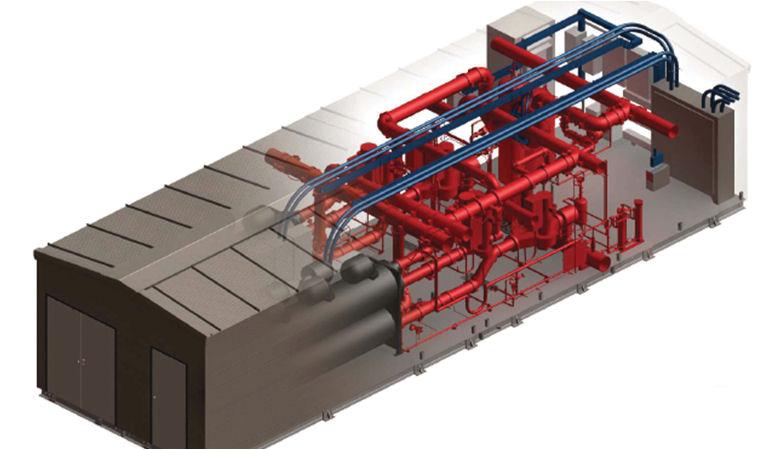

With the UK generating more electricity from offshore wind than any other country, the wheels are in motion to produce 40GW of offshore wind, including 1GW of innovative floating offshore wind, in the blusterous parts of the seas by 2030.
Offshore wind farms are growing at pace, with the world’s largest farm based in the North Sea. This challenging environment will soon be supplemented by ‘floating solar parks’, which will boost renewable energy in Europe and help reduce reliance on Russian gas. Floating solar panels have already been successfully installed inland and near-shore, but panels deployed off-shore must be able to withstand harsher conditions such as high winds, strong waves and saltwater corrosion.
Projects like the North Sea will see photovoltaic panels floating several metres above the water. Once installed, they will utilise the same undersea cables that carry electricity generated by wind turbines ashore, meaning complex infrastructure is not required to set them up.
With the need for secure, sustainable and affordable energy now unavoidable, projects like these offer a solution to land scarcity and allow for combined wind and solar offshore facilities to be developed. For example, countries with lower wind speeds but high solar irradiation will still be able to benefit.
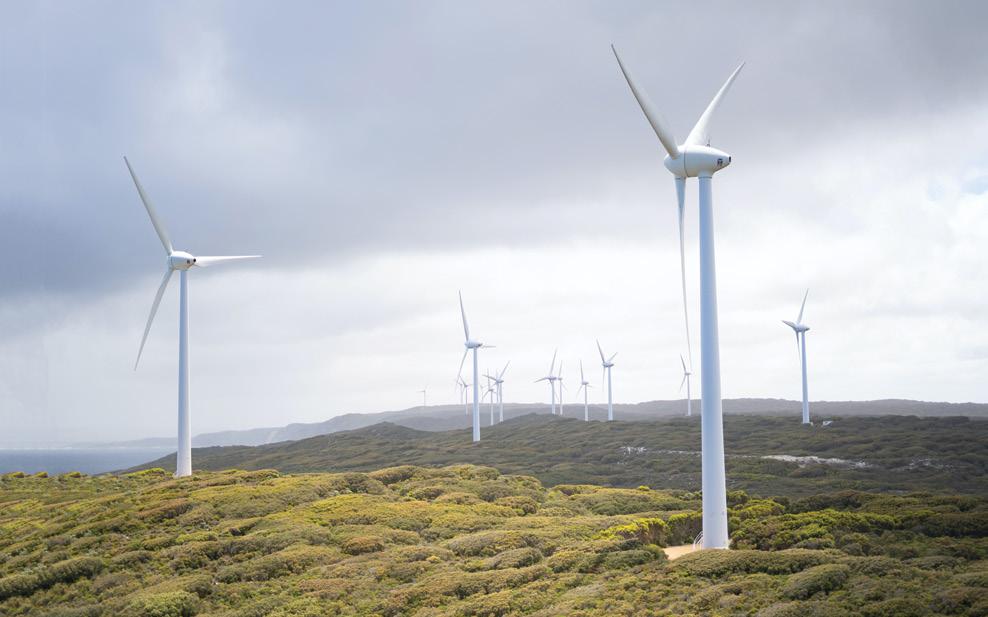

However, rising temperatures continue to cause severe weather conditions and wind turbine structures are constantly in danger of succumbing to lightning strikes. Factors such as installing extra equipment to monitor visibility, warning of the approach of severe weather and lowering risks for those working in close proximity must be considered.
All wind turbine parks are equipped with aviation obstruction (warning) lights, which for several years created light pollution and led to residents objecting to wind farm development. To combat this, Germany has had legislation in place since 2004 which requires developers and manufacturers to install turbines with visibility sensor-
controlled obstruction lights. These visibility sensors constantly monitor the local meteorological conditions and when the weather varies, the light intensity for the warning lights is automatically adjusted to its surroundings.
For example, on clear days where the visibility is greater than 10km, the light intensity is reduced to 10%. When the visibility is measured at 5km or higher, the light intensity is set to 30%. At all other times of lower visibility, it’s set to 100%.
In addition to visibility data being used to control the obstruction light brightness on wind turbines, present weather sensors are often installed to enhance the readings. These sensors output the specific weather conditions being experienced by the sensor at the top of the turbine in addition to the visibility information. This is important when the turbines are subjected to freezing conditions and the blades can become coated in ice, which can greatly reduce its efficiency.
In most cases, the turbines must be shut down and blades de-iced before they can be restarted. Having real-time weather data allows the operators to either plan for this more proactively or start their blade heating systems to reduce ice build-up and eliminate downtime.
In many applications, a thunderstorm detector is used to help protect people and equipment from the dangers of a lightning strike by providing advanced warning of a storm’s approach. This is especially true of tall structures sited on either exposed or flat landscapes where they are likely to initiate a lightning strike. Detectors which rely on lightning alone are only effective if the storm is already producing lightning at a distance before moving
closer towards the site. If a thunderstorm develops overhead, the first lightning strike will be very local and as there is no advanced warning, there is no protection.
In wind turbine applications, advanced warning of overhead lightning is of enormous benefit for installation teams, operation and maintenance staff. Turbines are prone to lightning strikes and all staff on-site need to be warned of a storm’s approach to make their way to a safe area. The same is true of offshore wind farms where the support vessels require warning of approaching storms to allow them to make the area safe.
With a renewables future under way, it is hoped that more is still to come in terms of what can be done with these structures. Following the announcement of the 10 Point Plan in 2020, the £12 billion project is already leading the country towards a ‘Green Industrial Revolution.’
Now two years on, we’re already seeing it being put into practice. The next few decades in renewable energy are set to be exciting, and with net zero deadlines in sight, the end result will boost renewable energy use in Europe for generations to come. www.biral.com/
 Kas Mohammed, VP Digital Energy at Schneider Electric
Kas Mohammed, VP Digital Energy at Schneider Electric
Sustainability is one of the most significant challenges businesses face today. The industrial revolution started a long journey of technological change that has transformed industry, society and the planet. Thankfully, there is a great deal of scrutiny of the need for cleaner, greener energy sources, the spirit of which we must carry forward towards building a more decarbonised and sustainable future.
Around 40% of the world’s CO2 emissions come from buildings and 30% of the energy consumed by buildings is wasted. Improving the energy efficiency of buildings is one of the fastest ways businesses can reduce greenhouse gas emissions and energy demand while also reducing operating costs.
Many technologies and solutions to decarbonise buildings already exist, including smart energy management tools and microgrids, but the right strategy is needed to maximise the benefits. Electricity 4.0 represents the convergence of digital technologies and clean, renewable energy at scale, driving innovation and efficiency, a fundamental shift in how we use, save and distribute energy.
We at Schneider Electric believe a more electric and digital world is the only way to address the climate challenge and enable a sustainable and resilient future. Pivoting to electricity generated by renewable energy sources is a muchneeded step to decarbonisation. However, this is not the whole picture – we also need digitalisation of the energy ecosystem for efficiency and scalability. Often the unsung hero, digital makes the invisible – energy waste – visible and allows us to break this barrier to see and measure our impact. This rings incredibly true for the building sector, which can be at the forefront of the energy revolution.
the decarbonisation process. Not only does electricity boost the efficiency of energy usage, but it is also a cleaner way to power buildings. Buildings can also be equipped to generate energy on-site through, for example, solar panels or wind turbines.
Digitisation of buildings is the next logical step. Sensors and automation help ensure energy is only used when and where needed. Digital tools also provide better and faster insights into our energy consumption. Combining this data with building management systems allows facility owners and managers to deploy resources better and make meaningful decisions that drive efficiency.
It’s also worth noting how crucial resiliency is to address the energy challenge. A true example of Electricity 4.0 in action is the modern microgrid, which makes use of a range of distributed energy resources, managed by a smart, automated microgrid control system. They are able to gather vital information and data to deliver cost-effective and resilient electricity access, sustainably and efficiently.
Electricity 4.0 requires the right digital technologies, much of which already exists, to help decarbonise through electricity.
and digital can innovate commercial buildings as we know them. Interoperable solutions, connected products, and digital technologies can be deployed to transform the way buildings consume energy and deliver sustainability and user experience.

Take IntenCity, in Grenoble, France, for example. It is one of the most sustainable office buildings in the world and an example of what can be achieved today. The commercial estate is 100% electric, entirely digitally designed and has complete energy autonomy, making it ten times more efficient than the average European building. The investment deployed to achieve such a feat will also be recouped within three to five years. The benefits are not limited to the environmental impact.
Away from the sustainable advantages of digitalising buildings are corporate ones. Managing energy usage and enhancing efficiency can lead to significant operational cost-saving benefits by reducing the amount of energy deployed, eliminating what we pay for but do not use.
The journey to a carbon-neutral future remains long and uncertain. We must keep innovating, reassessing, and redesigning how we produce, utilise and store energy.
Electricity 4.0 can create tangible change for commercial buildings. Switching to renewable energy sources instead of fossil fuels to generate electricity can kick-start
Software and connected smart technologies are readily available, enabling control over the building’s “shell” and heating system if deployed correctly. This makes smart and energy-efficient buildings possible. Not just that, these technologies can be used to retrofit existing buildings and in new builds. Combining electric
Electricity 4.0 is the next energy revolution that will answer the need for efficiency and sustainability. The resources already exist. It is just a matter of when and where we will decide to invest in them.
https://www.se.com/

Continued volatility in the energy market
companies must also focus on managing overall consumption. Thanks to tightening legislation, this will need to be achieved in tandem with a net-zero approach. In this article, Jodie Eaton, CEO of Shell Energy UK Limited, gives her advice to help energy managers navigate market complexities and accelerate their decarbonisation strategies.
The cheapest unit of electricity is the one that you don’t use and cutting energy use wherever possible must underpin both your procurement and netzero strategies. Minimising the amount you want to buy should be the priority.
One route that gives a level of certainty in a volatile energy market is power purchase agreements (PPAs). These contracts with renewable electricity generators can help businesses to achieve sustainability goals and lock in long-term pricing for eco-friendly electricity, helping to manage the risk of volatile power markets while generating savings on energy bills.
There are a wide range of PPAs available, which means expert advice is key to choosing the best option for your requirements. Using a third party to manage your PPA also helps. They can handle the power operations and balancing for you, as well as fix and manage the power price along the tenure of the PPA and help you promote the environmental attributes for both reporting purposes and to keep stakeholders up to date on your environmental performance.
If you are looking for certainty, a baseload PPA can be tailored to your demand and attached to an assetspecific Renewable Energy Guarantee of Origin (REGO)1. This gives businesses the reassurance of fixed tenor, fixed volume and fixed price. This type of PPA can be incorporated (sleeved) into a standard flex contract, for example.
Another option is financial flexible PPAs that are supported by asset specific 1 https://www.ofgem.gov.uk/environmentaland-social-schemes/renewable-energyguarantees-origin-rego
REGOs, which deliver improved price risk management without impacting on the supply contract; and ‘as produced’ PPAs, where the customer takes a generation mix and works with the supplier to develop a solution that matches their risk profile and energy needs.
Securing volume ahead of time, even if you have to pay an upfront margin, is better than volatility, which is likely to be a characteristic of the energy market for the long-term, especially as the supply mix transitions to increased levels of intermittent renewable sources.
Getting a mix that is right for your business is critical, so work with your supplier to nail down contract terms and conditions, as well as hedging support. In this way you can be confident of expert advice to manage future as well as current needs in ways that can make a fundamental difference to energy cost management.
Another reason to work closely with your supplier is that the market is in transition. The Government is clear that it wants big business to innovate and come up with their own solutions within the framework of delivering decarbonisation.
Not only that, but the Government has also just concluded the consultation into its first Review of Electricity Market Arrangements (REMA) for more than 20 years.
Described as potentially ‘the biggest electricity market shake-up in decades’2, the proposals are designed

2 https://www.gov.uk/government/news/uklaunches-biggest-electricity-market-reform-ina-generation
to deliver a step change in the rate of deployment of low carbon technologies, reduce dependence on fossil fuelled generation, encourage flexibility across the system, optimise assets, use pricing to encourage change in consumer use and maintain system security.
A key element of proposals considers the potential shift from national pricing to locational pricing. Options include nodal pricing, also known as locational marginal pricing (LMP) that could see the UK moving from one single market to up to circa 750 pricing markets.
A more likely approach is zonal pricing where the network is divided into different zones such as a north/ south split. Each area would have its own single wholesale price for electricity with boundaries reflecting major transmission constraints.
Having the right expertise available to help optimise energy efficiency, drive procurement performance and guide you through all the upcoming changes will deliver significant benefit.
Working collaboratively with your supplier is crucial to developing a long-term strategy that will keep you in control. To get the most benefit from the relationship you should engage with your selected supplier for as long as possible so that they not only work with you, but also invest in the contract to help you to achieve better returns and support your business’ journey through the energy transition. www.shellenergy.co.uk/business
has brought cost into sharp focus. Buying better is no longer enough,

The transition to renewablesbased energy generation is driving significant change in energy markets around the world. As renewables replace traditional power generation, balancing supply to meet demand is less straightforward. Different physical properties, weather-dependency, volatility and uncertainty increase the need for flexibility in both demand and generation to achieve that balance.
The UK’s energy flexibility markets are among the world’s most advanced. They maintain a reliable energy system in the face of an imbalance between supply and demand or help recovery after a power system event. As one of the first regions to evolve its energy mix with a higher penetration of renewable energy, the UK is a leading innovator in flexibility markets.
Flexibility markets balance the grid by releasing power back to the grid when demand is high (or supply is low) and consuming it when supply is high (or demand is low). As the flexibility markets open up and evolve, they create new opportunities for businesses to realise value from their energy assets.
As energy users, businesses can reduce costs or receive payment for being flexible with their energy consumption or by making their energy
assets (e.g. on-site generation or back-up power) available into different markets.
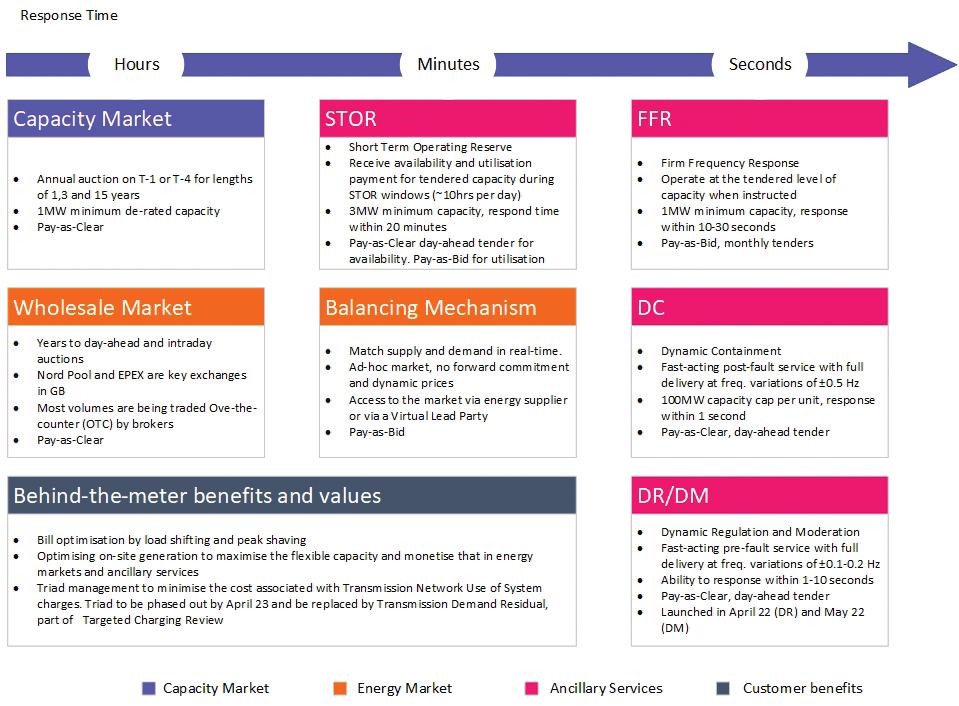
Alongside the rewards there are also challenges. Energy flexibility markets are constantly evolving and complex to navigate. Broadly there are four markets: Capacity Market; Ancillary Services; Energy Markets and Customer benefits – with different programmes or value streams in each market.
Understanding different markets and their programmes and forecasting obtainable value takes knowledge and resources few businesses have in-house. Reliable systems are also essential to access and participate in the market and optimise an asset’s position in the available markets and programmes.
Success in energy flexibility markets involves understanding the requirements, market trends and dynamics, evaluating risks, defining strategies, bidding, responding and settling. There are barriers to entry in most, up-front costs are a typical requirement. This calls for an in-depth understanding of the markets and an assessment of the financial risks. Being unable to meet certain requirements, for example, or failing to deliver during events can incur financial penalties.
Businesses can participate in flexibility markets with different asset types including curtailment of different loads, utilisation of on-site generation through solar and wind, gas engines and also using Combined Heat and Power (CHP) or ‘co-generation’.
One of the most versatile assets in flexibility markets is battery energy storage systems (BESS). The ability to respond in both directions by charging (importing) and discharging (exporting) the asset
and the fast response rate (typically <1 second) allows BESS to be the most effective asset in most flexibility markets.

Many businesses deploy BESS ‘behind-the-meter’ (BTM) to provide standby power for resilience and recovery after an energy event, to improve the quality of power, to store self-produced energy, and to enable other technologies if local grids are constrained.
The versatility of BESS is illustrated by the growth in the UK pipeline during 2021 when deploying utility-scale battery energy storage shot up 70% on 2020 levels. The total installed capacity of utility-scale storage approached 1.7 GW across 127 sites in the UK in 2021, with the pipeline of future projects increasing to 27 GW1
The primary function of battery storage used behind the meter will always be to satisfy the operational needs of the site. If the stored energy is not required, or there is spare capacity, it can be used to participate in flexibility markets.
The use of both BTM and FTM battery projects in flexibility markets needs to be optimised to maximise earnings. Optimising FTM projects across multiple markets will improve potential return.
FTM battery optimisation maximises the value that can be obtained from ancillary services and energy markets. Battery assets are currently eligible to trade in ten key programmes in the UK: Dynamic Containment Low2 (DCL) and High (DCH), Dynamic Moderation 1 https://www.energy-storage.news/thenumbers-behind-the-record-breaking-rise-ofthe-uk-battery-storage-market/ 2 “Low” frequency programmes are activated when the system frequency drops too low and assets need to export, “High” programmes when the frequency is too high and assets need to import
Low (DML) and High (DMH), Dynamic Regulation Low (DRL) and High (DRH), Firm Frequency Response (FFR), Short Term Operating Reserve (STOR), Wholesale and Balancing Mechanism (BM). Being the only technology able to participate in all these programmes gives battery assets an advantage to unlock the full market potential, however it also implies having to develop more complex bidding strategies and to deal with higher uncertainty.
Over the past eleven months frequency programmes have represented more than 90% of battery profits3 in the UK, followed by wholesale and lastly BM. A common day-to-day bidding strategy relies on frequency programmes revenues and moving to wholesale and BM only in days/hours of high price spreads e.g., during the volatility seen during the heatwave in July.
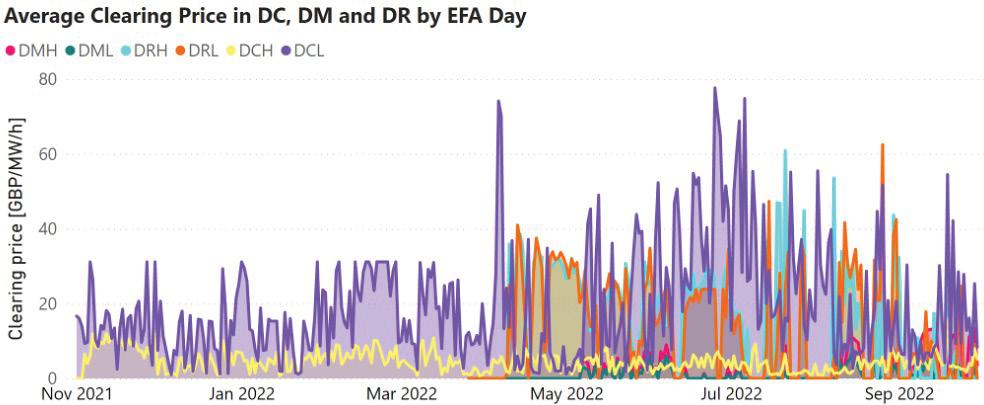

Frequency programmes in the UK have seen deep changes in the last couple of years:
Before October 2020, Enhanced Frequency Response (EFR) and FFR were the only frequency programmes available to batteries. EFR was a one-off tender and has been discontinued while FFR has been partly replaced by some of the new frequency programmes and will be phased out in the next couple of years.
In Oct 2020, Dynamic Containment Low was launched as a daily service with availability payment flat at 17 GBP/MW/h. This started allowing a first form of daily optimisation across ancillary services and energy market.
In Nov 2021, DCL was changed to be a pay-as-clear programme tendered by EFA block4. Dynamic Containment High was introduced, and batteries started to be able to be available in both DCL and DCH in the same EFA block. These changes to the market increased the ability of batteries to participate in multiple programmes.
In Apr-May 2022, Dynamic Moderation Low and High and Dynamic Regulation Low and High programmes were introduced with the same commercial characteristics as Dynamic Containment. This increased
3 Profits = revenues – costs in energy markets and ancillary services
4 EFA blocks are six four-hour blocks within the EFA day (11pm to 11pm in the following day)
the number of new dynamic frequency programmes from two to six.
Since DCL was firstly introduced, the new frequency programmes have represented an important portion of battery profits. Understanding trends and drivers of contracted volumes and clearing prices is key for optimisers to develop a bidding strategy.
The average contracted volumes in the new frequency programmes increased almost fourfold from 427 MW in Nov 21 to 1,520 MW in Sept 22. Dynamic Containment still represents almost all of the contracted volumes; however Dynamic Regulation has started to get significant interest5 and Dynamic Moderation is expected to follow.
The increase in contracted volumes is a good sign for battery developers as it increases the chances of being contracted and is often a stimulus for prices to increase as well. However, despite the upward trend being quite evident, daily variations in contracted volumes can be very significant. To help developers build better forecasts, the National Grid started publishing forecasts of Dynamic Containment
5 Strategies involving Dynamic Regulation have been performing well over the last months, however this programme still represents a small portion of the total contracted volumes as both DRL and DRH are currently capped at 100 MW
requirements for the following four days; these are updated on a daily basis.

The high volatility that we have seen in contracted volumes also applies to clearing prices6. Clearing prices for DCL – the most volatile programme – have ranged from 0.01 GBP/MW/h to more than 100 GBP/ MW/h. Since its start, Dynamic Regulation has also been clearing at very high prices, however since DRH started to reach saturation the clearing prices in this programme have dropped.
Overall, the high volatility, the limited historic data and the numerous options in DC, DM and DR make it hard to forecast prices and volumes in these programmes. Bidding strategies that consider the new frequency programmes in the optimisation need to be able to handle uncertainty. The value in this market is high at the moment and battery optimisers tend to prefer it to the energy market. As a limited market, as more assets enter there will be a downward pressure on prices and the ability to move to other markets becomes key.
Unlike the new set of frequency programmes, wholesale and balancing mechanism are technology-neutral
6 Clearing prices refer to availability payments, no energy payment is made based on import/ export volumes.
programmes with a longer history of operation which offers a larger future opportunity based on the volume requirements. Both programmes offer several options to monetise volatility for a battery asset.
Wholesale trading in the UK can happen in two main exchanges: EPEX and Nord Pool. The day-ahead clearing prices of the two pools are correlated but may differ significantly in some settlement periods. In addition, despite day-ahead trading seeing the highest volumes, intraday trading is gaining attention. Similarly, the balancing mechanism gives participants the option to bid/offer capacity, and also to import/ export at imbalance price and to stack bids/offers with frequency programmes.
Day-ahead trading offers the most secure way to access revenues in the energy market for two reasons: the day-ahead forecasts for the wholesale market are the most accurate and unlike balancing mechanism there is a guarantee of volumes being traded. A key strategy for a BESS to take advantage of market volatility is to secure volumes in the day-ahead market and try to
get extra profits in the balancing mechanism. This offers a potential for batteries to import electricity for free, or being paid to do so and to export at extremely high prices. However, securing volumes in this market can be tricky as both acceptance rate and call durations are low for batteries. Similarly, trading at the imbalance price is risky as the forecasts for this market are inaccurate and the prices can change drastically from one settlement to another.
To sum up, at the moment wholesale is more attractive than BM for FTM batteries in securing profits on the energy market. However, National Grid has acknowledged that the low acceptance rate of small units (and therefore batteries) in the BM is something that they are planning to improve in the coming years. It is expected that in the future a higher potential could be unlocked for batteries in the balancing mechanism.
The increasing and ever-changing choice of options and the range of
assets needed to meet the demands of the coming decades will see owners and operators use new technology that integrates with their systems. The need for rapid decision-making will put the focus on intelligent technology with automated real-time control and measurement. Only this will enable asset owners to optimise margins and develop projects to realise the value of their assets.
Even now, advanced technology driven by machine learning and AI is enabling developers and operators to manage multiple assets across multiple markets to optimise returns and exploit new and emerging revenue streams.


Technology alone is not enough. A trusted energy partner with the scale and expertise to provide strategic advice, alongside innovative technology, is crucial to overcome the complexity, reduce risk and ultimately optimise asset value to be successful in flexibility markets. https://www.enelx.com/

Partnering with YPO and CCS to deliver a single platform to manage your entire energy portfolio using cloud technology.
We understand the pressures of meeting budgets and becoming more efficient while making plans for net zero. We have worked with the public sector for many years and understand the high importance of embedding digital tools into current processes to meet these demands.
Utilidex is an integrated platform delivering 3 core modules to empower our energy customers to do more. Data Platform to manage your whole portfolio and all site changes, Bill Validation to check energy bills are accurate, and Energy Analytics to track consumption, carbon, and cost.

Store your whole portfolio in one single place and easily access all your key site info
Easily manage any change of tenancies and alert suppliers right away
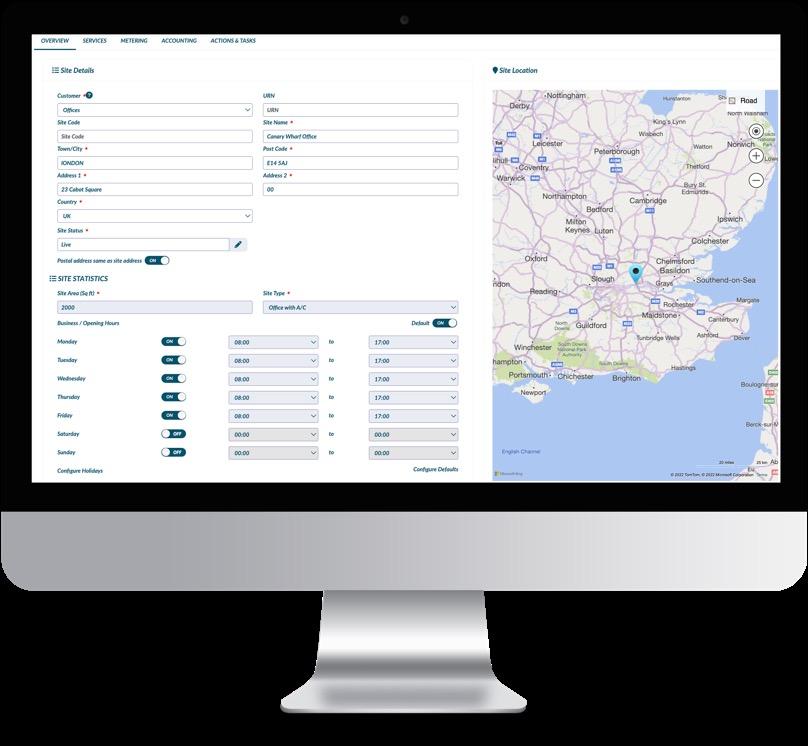
Easily input your budgets and track over/under spending sites
Customise your own PPU to meet your increased energy cost and produce accruals to accurately forecast your expected cost
Collect half hourly and non half hourly data and benchmark against various categories

View consumption and spot outliers through a suite of different tools such as dashboards, Power BIs (Business Intelligence tools), automated reports and alerts
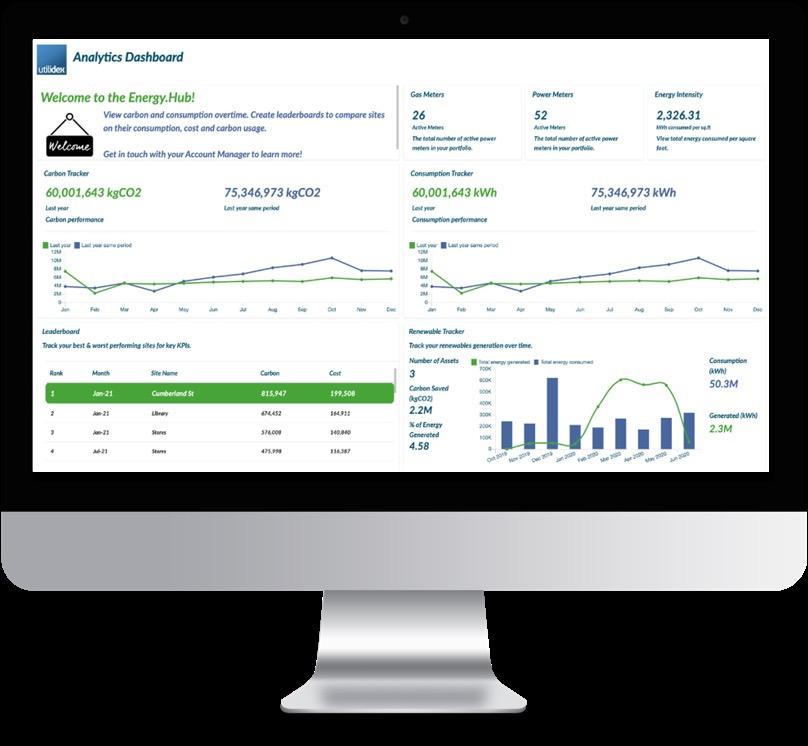
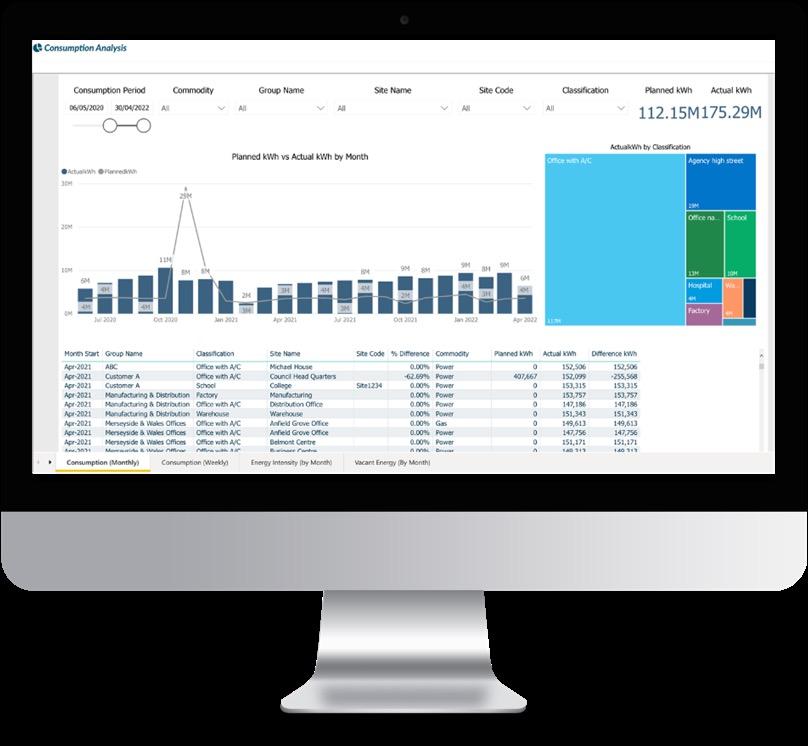
Connect accounting systems for a straight through process and create customised dashboards for internal messaging
Automate key reports to the right people at the right time, whether Finance needs a monthly view of energy cost or the Sustainability team needs to forecast carbon reduction from the previous year
Discover more about Utilidex by visiting our website www.utilidex.com

Our heating controls are always striving to use less energy, while keeping rooms at a comfortable temperature. Allowing heat boost, but reverting to setback temperatures after pre-set times and, reducing heat input when rooms are empty or if windows are open, are just some of the features that lead to Irus and ecostat2 typically saving 30%-40% on energy costs.


Visit our website to find out more about how we cleverly, but simply, control energy use.
Central control Local control